Social Anxiety Disorder Survey
VerifiedAdded on 2020/03/07
|21
|4193
|62
AI Summary
This assignment presents a survey focused on understanding social anxiety disorder. Participants answer questions about their experiences with anxiety, including physical symptoms, triggers, frequency of attacks, help-seeking behaviors, and social discomfort. The survey also delves into how social situations compare to other stressors in causing anxiety and provides space for respondents to elaborate on their feelings.
Contribute Materials
Your contribution can guide someone’s learning journey. Share your
documents today.
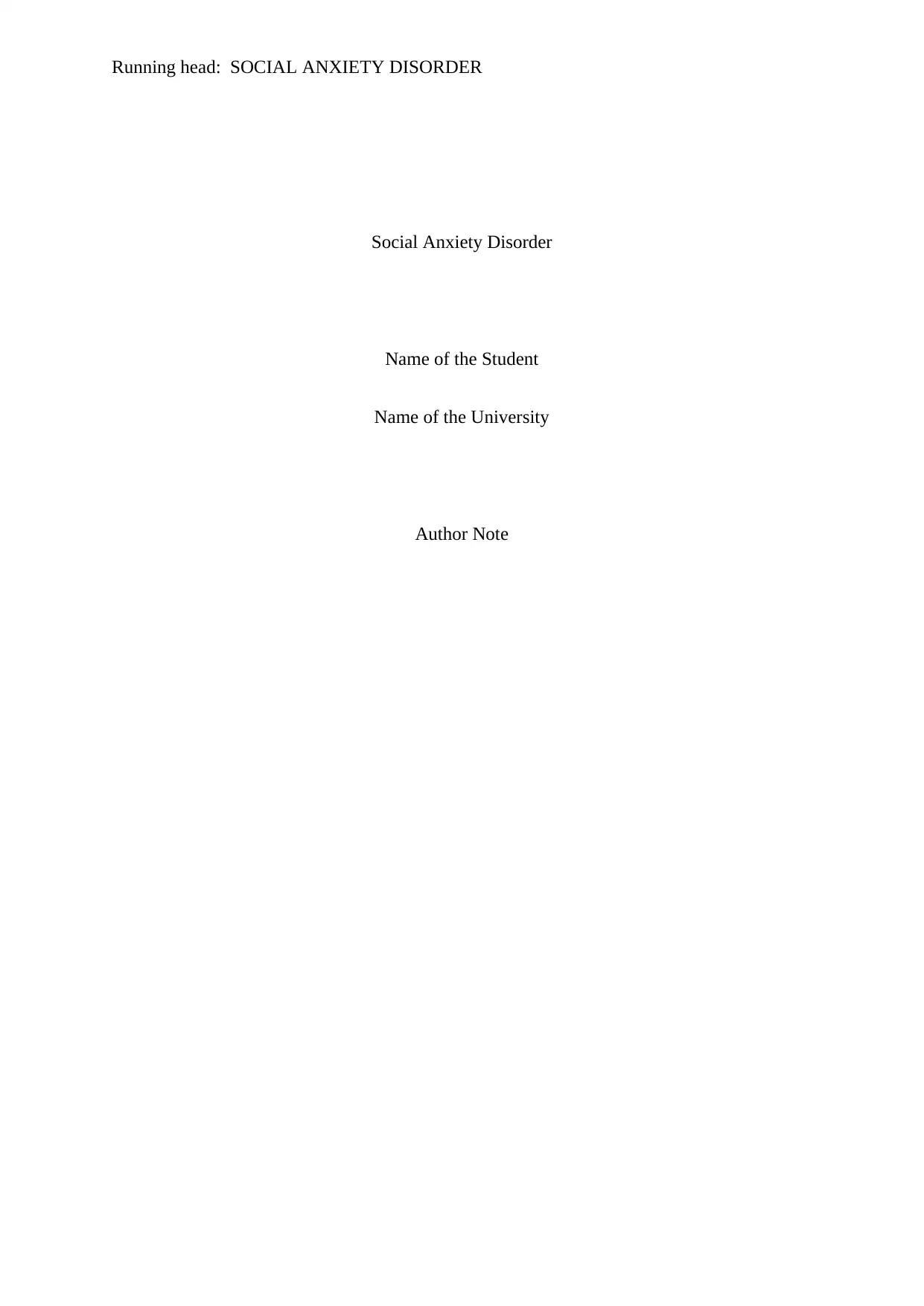
Running head: SOCIAL ANXIETY DISORDER
Social Anxiety Disorder
Name of the Student
Name of the University
Author Note
Social Anxiety Disorder
Name of the Student
Name of the University
Author Note
Secure Best Marks with AI Grader
Need help grading? Try our AI Grader for instant feedback on your assignments.
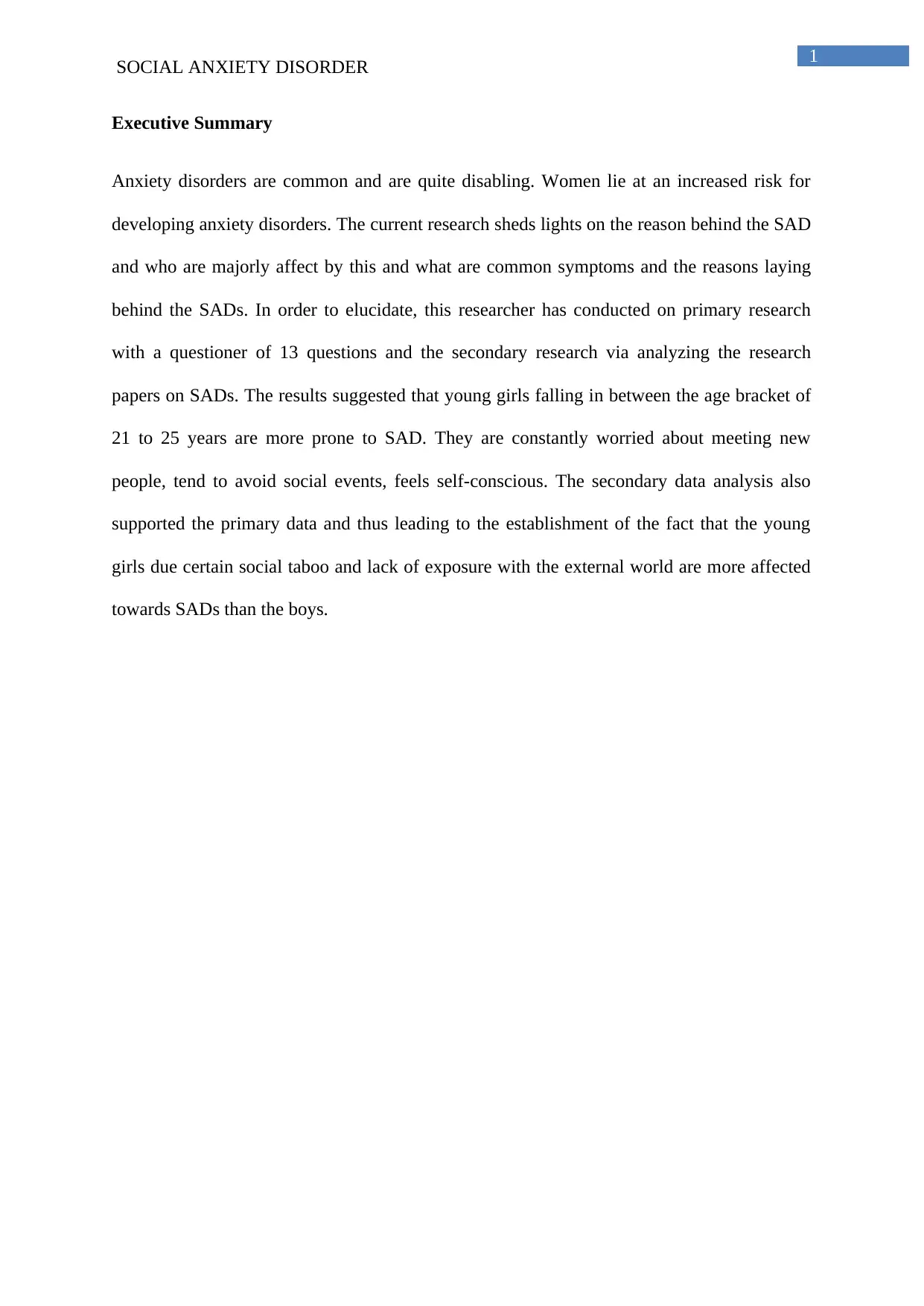
1
SOCIAL ANXIETY DISORDER
Executive Summary
Anxiety disorders are common and are quite disabling. Women lie at an increased risk for
developing anxiety disorders. The current research sheds lights on the reason behind the SAD
and who are majorly affect by this and what are common symptoms and the reasons laying
behind the SADs. In order to elucidate, this researcher has conducted on primary research
with a questioner of 13 questions and the secondary research via analyzing the research
papers on SADs. The results suggested that young girls falling in between the age bracket of
21 to 25 years are more prone to SAD. They are constantly worried about meeting new
people, tend to avoid social events, feels self-conscious. The secondary data analysis also
supported the primary data and thus leading to the establishment of the fact that the young
girls due certain social taboo and lack of exposure with the external world are more affected
towards SADs than the boys.
SOCIAL ANXIETY DISORDER
Executive Summary
Anxiety disorders are common and are quite disabling. Women lie at an increased risk for
developing anxiety disorders. The current research sheds lights on the reason behind the SAD
and who are majorly affect by this and what are common symptoms and the reasons laying
behind the SADs. In order to elucidate, this researcher has conducted on primary research
with a questioner of 13 questions and the secondary research via analyzing the research
papers on SADs. The results suggested that young girls falling in between the age bracket of
21 to 25 years are more prone to SAD. They are constantly worried about meeting new
people, tend to avoid social events, feels self-conscious. The secondary data analysis also
supported the primary data and thus leading to the establishment of the fact that the young
girls due certain social taboo and lack of exposure with the external world are more affected
towards SADs than the boys.
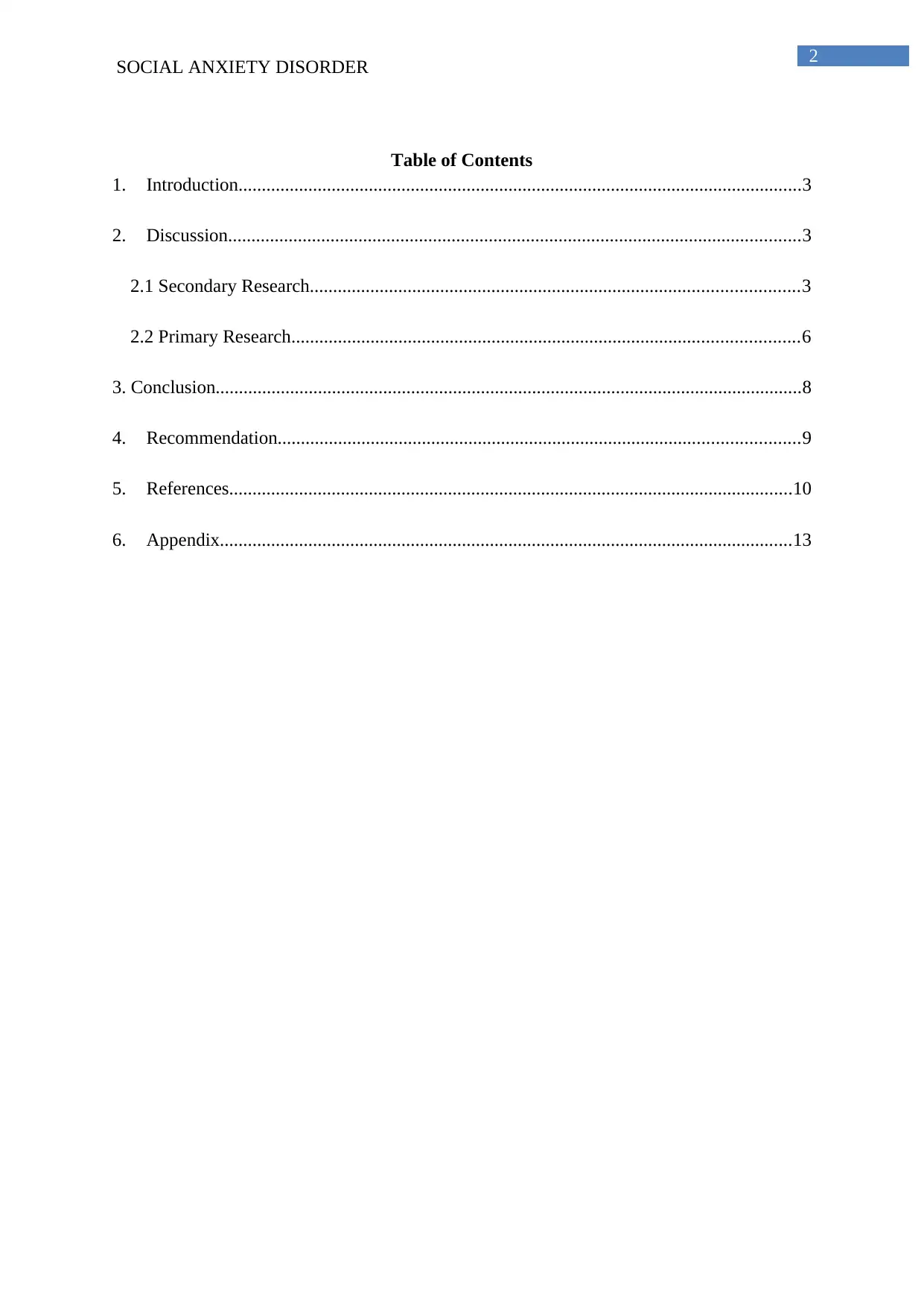
2
SOCIAL ANXIETY DISORDER
Table of Contents
1. Introduction.........................................................................................................................3
2. Discussion...........................................................................................................................3
2.1 Secondary Research.........................................................................................................3
2.2 Primary Research.............................................................................................................6
3. Conclusion..............................................................................................................................8
4. Recommendation................................................................................................................9
5. References.........................................................................................................................10
6. Appendix...........................................................................................................................13
SOCIAL ANXIETY DISORDER
Table of Contents
1. Introduction.........................................................................................................................3
2. Discussion...........................................................................................................................3
2.1 Secondary Research.........................................................................................................3
2.2 Primary Research.............................................................................................................6
3. Conclusion..............................................................................................................................8
4. Recommendation................................................................................................................9
5. References.........................................................................................................................10
6. Appendix...........................................................................................................................13
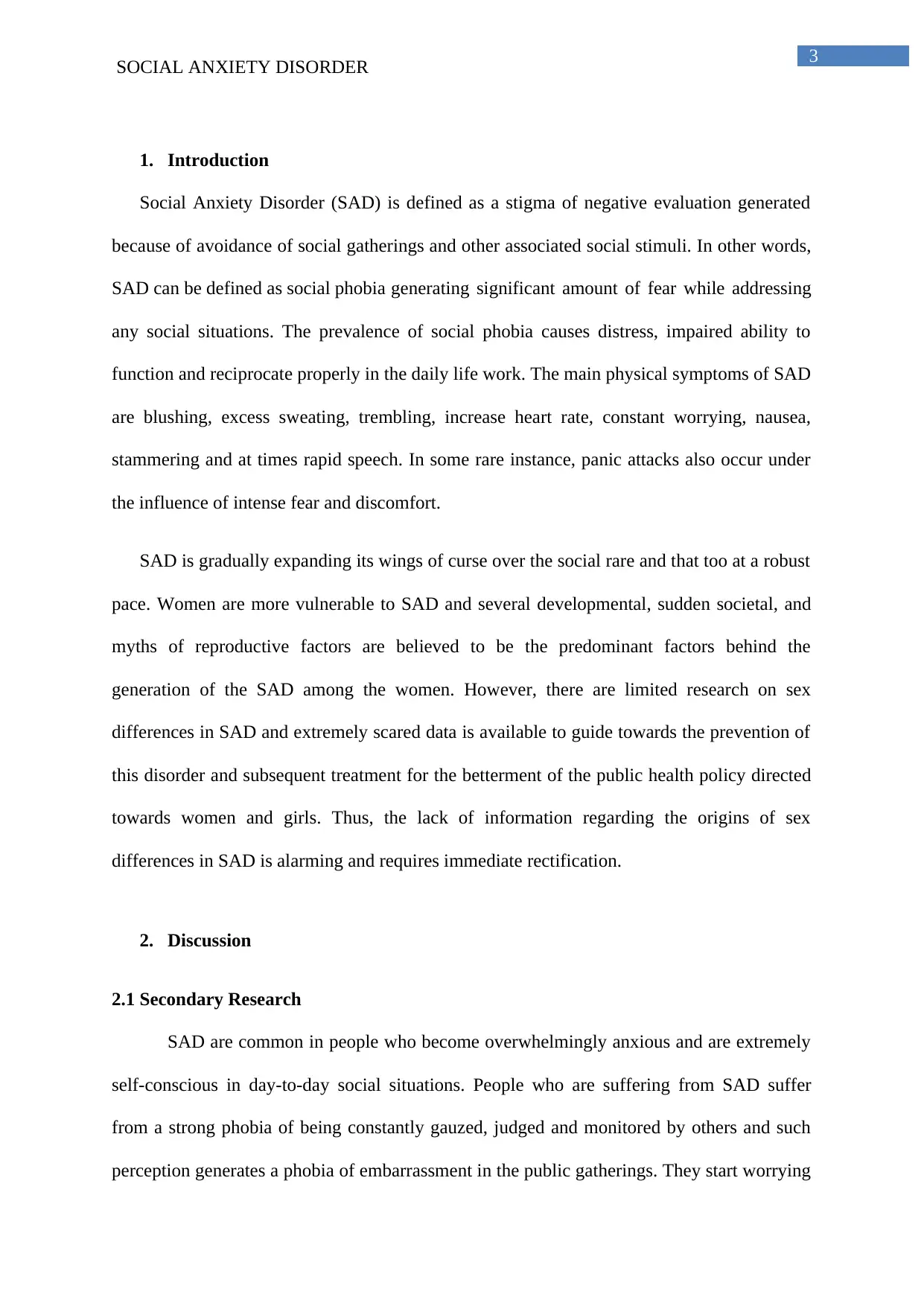
3
SOCIAL ANXIETY DISORDER
1. Introduction
Social Anxiety Disorder (SAD) is defined as a stigma of negative evaluation generated
because of avoidance of social gatherings and other associated social stimuli. In other words,
SAD can be defined as social phobia generating significant amount of fear while addressing
any social situations. The prevalence of social phobia causes distress, impaired ability to
function and reciprocate properly in the daily life work. The main physical symptoms of SAD
are blushing, excess sweating, trembling, increase heart rate, constant worrying, nausea,
stammering and at times rapid speech. In some rare instance, panic attacks also occur under
the influence of intense fear and discomfort.
SAD is gradually expanding its wings of curse over the social rare and that too at a robust
pace. Women are more vulnerable to SAD and several developmental, sudden societal, and
myths of reproductive factors are believed to be the predominant factors behind the
generation of the SAD among the women. However, there are limited research on sex
differences in SAD and extremely scared data is available to guide towards the prevention of
this disorder and subsequent treatment for the betterment of the public health policy directed
towards women and girls. Thus, the lack of information regarding the origins of sex
differences in SAD is alarming and requires immediate rectification.
2. Discussion
2.1 Secondary Research
SAD are common in people who become overwhelmingly anxious and are extremely
self-conscious in day-to-day social situations. People who are suffering from SAD suffer
from a strong phobia of being constantly gauzed, judged and monitored by others and such
perception generates a phobia of embarrassment in the public gatherings. They start worrying
SOCIAL ANXIETY DISORDER
1. Introduction
Social Anxiety Disorder (SAD) is defined as a stigma of negative evaluation generated
because of avoidance of social gatherings and other associated social stimuli. In other words,
SAD can be defined as social phobia generating significant amount of fear while addressing
any social situations. The prevalence of social phobia causes distress, impaired ability to
function and reciprocate properly in the daily life work. The main physical symptoms of SAD
are blushing, excess sweating, trembling, increase heart rate, constant worrying, nausea,
stammering and at times rapid speech. In some rare instance, panic attacks also occur under
the influence of intense fear and discomfort.
SAD is gradually expanding its wings of curse over the social rare and that too at a robust
pace. Women are more vulnerable to SAD and several developmental, sudden societal, and
myths of reproductive factors are believed to be the predominant factors behind the
generation of the SAD among the women. However, there are limited research on sex
differences in SAD and extremely scared data is available to guide towards the prevention of
this disorder and subsequent treatment for the betterment of the public health policy directed
towards women and girls. Thus, the lack of information regarding the origins of sex
differences in SAD is alarming and requires immediate rectification.
2. Discussion
2.1 Secondary Research
SAD are common in people who become overwhelmingly anxious and are extremely
self-conscious in day-to-day social situations. People who are suffering from SAD suffer
from a strong phobia of being constantly gauzed, judged and monitored by others and such
perception generates a phobia of embarrassment in the public gatherings. They start worrying
Secure Best Marks with AI Grader
Need help grading? Try our AI Grader for instant feedback on your assignments.
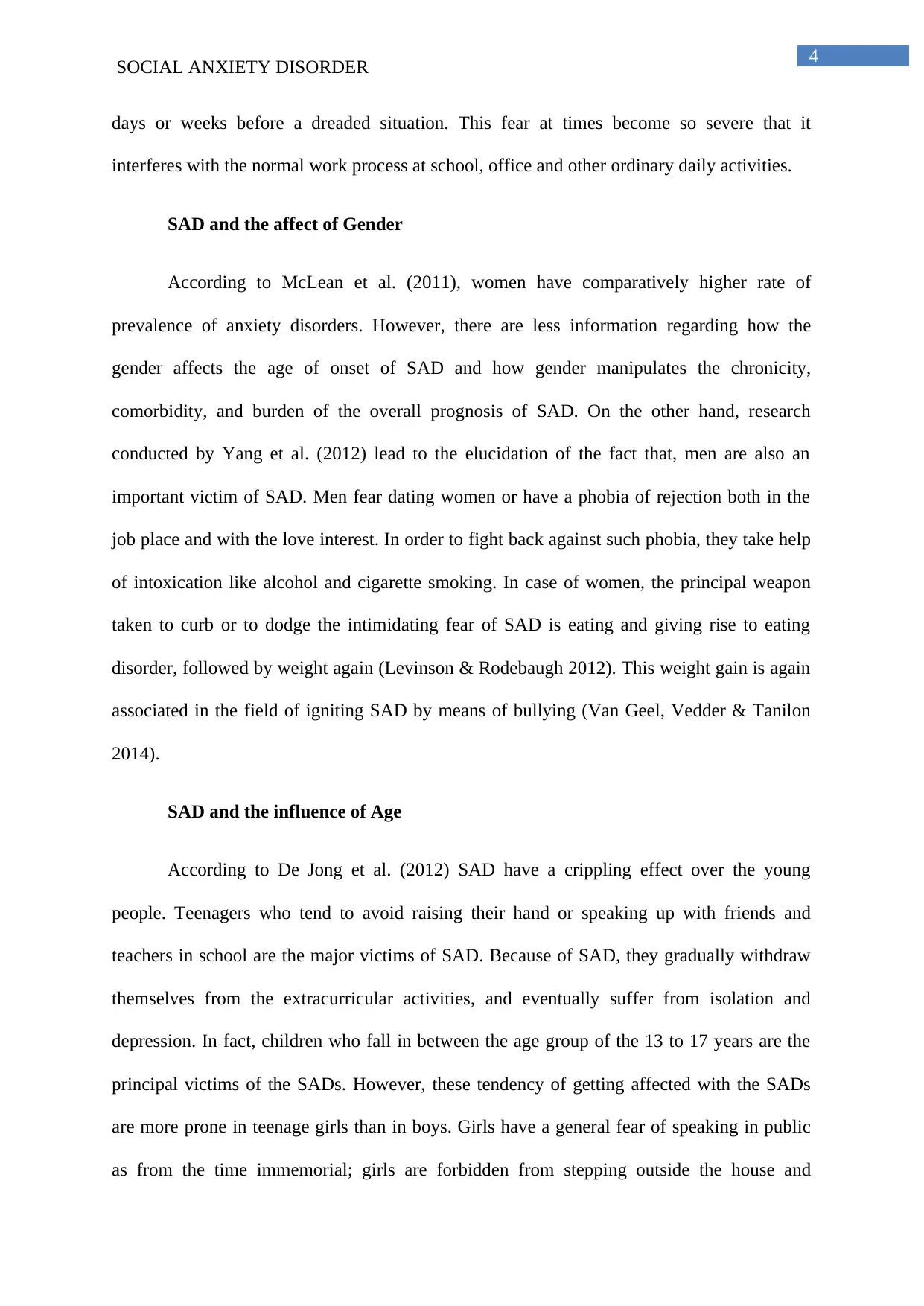
4
SOCIAL ANXIETY DISORDER
days or weeks before a dreaded situation. This fear at times become so severe that it
interferes with the normal work process at school, office and other ordinary daily activities.
SAD and the affect of Gender
According to McLean et al. (2011), women have comparatively higher rate of
prevalence of anxiety disorders. However, there are less information regarding how the
gender affects the age of onset of SAD and how gender manipulates the chronicity,
comorbidity, and burden of the overall prognosis of SAD. On the other hand, research
conducted by Yang et al. (2012) lead to the elucidation of the fact that, men are also an
important victim of SAD. Men fear dating women or have a phobia of rejection both in the
job place and with the love interest. In order to fight back against such phobia, they take help
of intoxication like alcohol and cigarette smoking. In case of women, the principal weapon
taken to curb or to dodge the intimidating fear of SAD is eating and giving rise to eating
disorder, followed by weight again (Levinson & Rodebaugh 2012). This weight gain is again
associated in the field of igniting SAD by means of bullying (Van Geel, Vedder & Tanilon
2014).
SAD and the influence of Age
According to De Jong et al. (2012) SAD have a crippling effect over the young
people. Teenagers who tend to avoid raising their hand or speaking up with friends and
teachers in school are the major victims of SAD. Because of SAD, they gradually withdraw
themselves from the extracurricular activities, and eventually suffer from isolation and
depression. In fact, children who fall in between the age group of the 13 to 17 years are the
principal victims of the SADs. However, these tendency of getting affected with the SADs
are more prone in teenage girls than in boys. Girls have a general fear of speaking in public
as from the time immemorial; girls are forbidden from stepping outside the house and
SOCIAL ANXIETY DISORDER
days or weeks before a dreaded situation. This fear at times become so severe that it
interferes with the normal work process at school, office and other ordinary daily activities.
SAD and the affect of Gender
According to McLean et al. (2011), women have comparatively higher rate of
prevalence of anxiety disorders. However, there are less information regarding how the
gender affects the age of onset of SAD and how gender manipulates the chronicity,
comorbidity, and burden of the overall prognosis of SAD. On the other hand, research
conducted by Yang et al. (2012) lead to the elucidation of the fact that, men are also an
important victim of SAD. Men fear dating women or have a phobia of rejection both in the
job place and with the love interest. In order to fight back against such phobia, they take help
of intoxication like alcohol and cigarette smoking. In case of women, the principal weapon
taken to curb or to dodge the intimidating fear of SAD is eating and giving rise to eating
disorder, followed by weight again (Levinson & Rodebaugh 2012). This weight gain is again
associated in the field of igniting SAD by means of bullying (Van Geel, Vedder & Tanilon
2014).
SAD and the influence of Age
According to De Jong et al. (2012) SAD have a crippling effect over the young
people. Teenagers who tend to avoid raising their hand or speaking up with friends and
teachers in school are the major victims of SAD. Because of SAD, they gradually withdraw
themselves from the extracurricular activities, and eventually suffer from isolation and
depression. In fact, children who fall in between the age group of the 13 to 17 years are the
principal victims of the SADs. However, these tendency of getting affected with the SADs
are more prone in teenage girls than in boys. Girls have a general fear of speaking in public
as from the time immemorial; girls are forbidden from stepping outside the house and
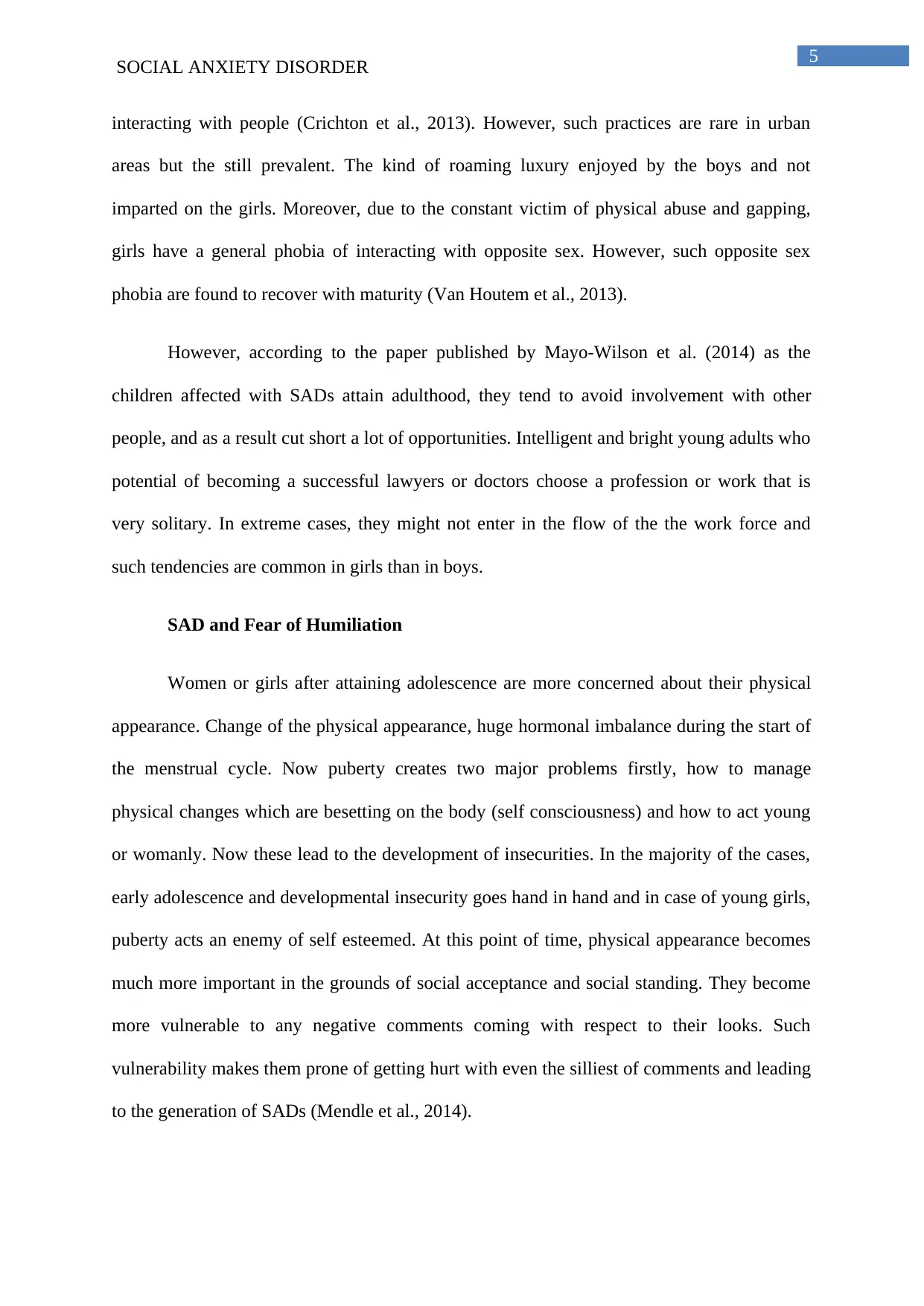
5
SOCIAL ANXIETY DISORDER
interacting with people (Crichton et al., 2013). However, such practices are rare in urban
areas but the still prevalent. The kind of roaming luxury enjoyed by the boys and not
imparted on the girls. Moreover, due to the constant victim of physical abuse and gapping,
girls have a general phobia of interacting with opposite sex. However, such opposite sex
phobia are found to recover with maturity (Van Houtem et al., 2013).
However, according to the paper published by Mayo-Wilson et al. (2014) as the
children affected with SADs attain adulthood, they tend to avoid involvement with other
people, and as a result cut short a lot of opportunities. Intelligent and bright young adults who
potential of becoming a successful lawyers or doctors choose a profession or work that is
very solitary. In extreme cases, they might not enter in the flow of the the work force and
such tendencies are common in girls than in boys.
SAD and Fear of Humiliation
Women or girls after attaining adolescence are more concerned about their physical
appearance. Change of the physical appearance, huge hormonal imbalance during the start of
the menstrual cycle. Now puberty creates two major problems firstly, how to manage
physical changes which are besetting on the body (self consciousness) and how to act young
or womanly. Now these lead to the development of insecurities. In the majority of the cases,
early adolescence and developmental insecurity goes hand in hand and in case of young girls,
puberty acts an enemy of self esteemed. At this point of time, physical appearance becomes
much more important in the grounds of social acceptance and social standing. They become
more vulnerable to any negative comments coming with respect to their looks. Such
vulnerability makes them prone of getting hurt with even the silliest of comments and leading
to the generation of SADs (Mendle et al., 2014).
SOCIAL ANXIETY DISORDER
interacting with people (Crichton et al., 2013). However, such practices are rare in urban
areas but the still prevalent. The kind of roaming luxury enjoyed by the boys and not
imparted on the girls. Moreover, due to the constant victim of physical abuse and gapping,
girls have a general phobia of interacting with opposite sex. However, such opposite sex
phobia are found to recover with maturity (Van Houtem et al., 2013).
However, according to the paper published by Mayo-Wilson et al. (2014) as the
children affected with SADs attain adulthood, they tend to avoid involvement with other
people, and as a result cut short a lot of opportunities. Intelligent and bright young adults who
potential of becoming a successful lawyers or doctors choose a profession or work that is
very solitary. In extreme cases, they might not enter in the flow of the the work force and
such tendencies are common in girls than in boys.
SAD and Fear of Humiliation
Women or girls after attaining adolescence are more concerned about their physical
appearance. Change of the physical appearance, huge hormonal imbalance during the start of
the menstrual cycle. Now puberty creates two major problems firstly, how to manage
physical changes which are besetting on the body (self consciousness) and how to act young
or womanly. Now these lead to the development of insecurities. In the majority of the cases,
early adolescence and developmental insecurity goes hand in hand and in case of young girls,
puberty acts an enemy of self esteemed. At this point of time, physical appearance becomes
much more important in the grounds of social acceptance and social standing. They become
more vulnerable to any negative comments coming with respect to their looks. Such
vulnerability makes them prone of getting hurt with even the silliest of comments and leading
to the generation of SADs (Mendle et al., 2014).
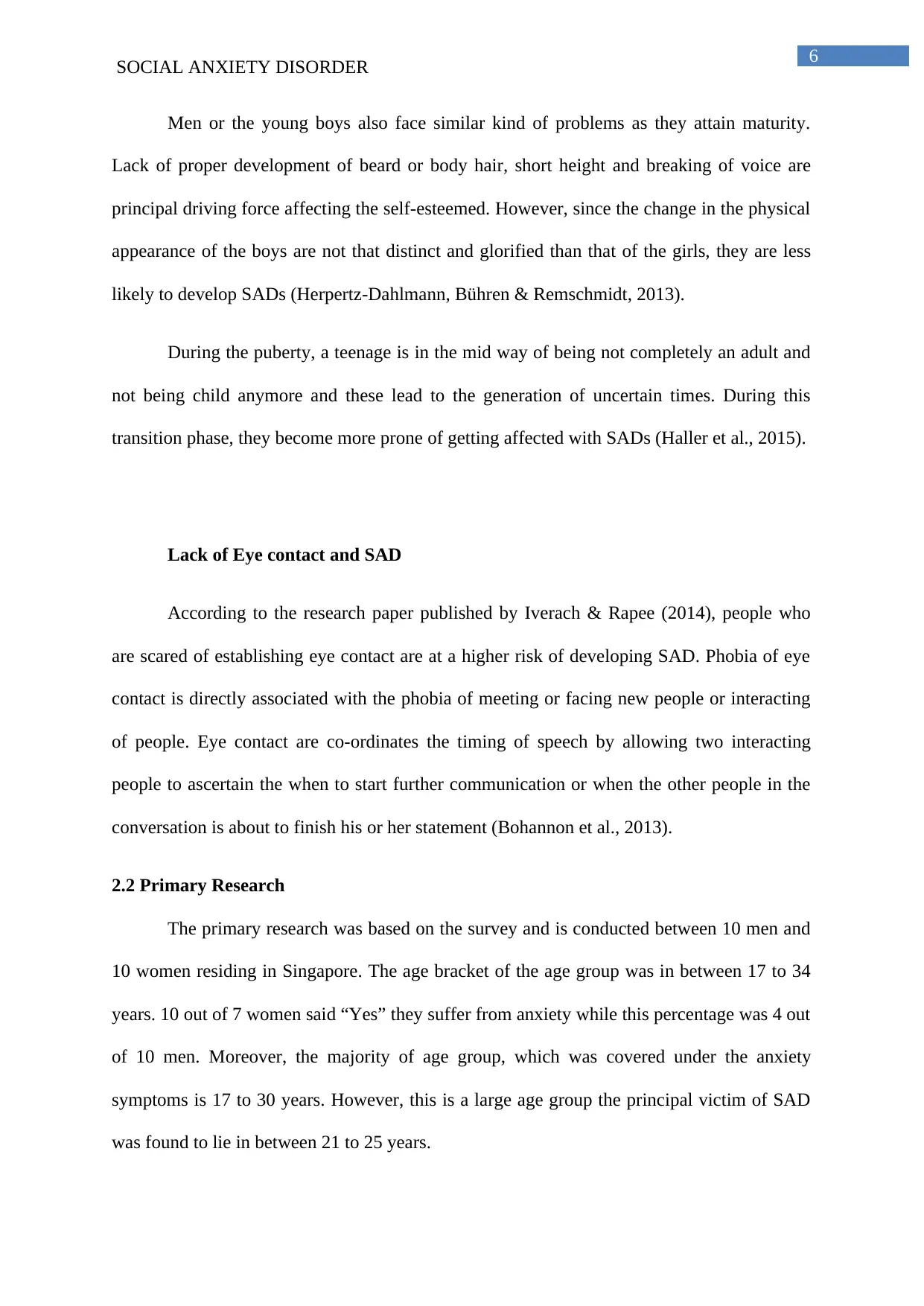
6
SOCIAL ANXIETY DISORDER
Men or the young boys also face similar kind of problems as they attain maturity.
Lack of proper development of beard or body hair, short height and breaking of voice are
principal driving force affecting the self-esteemed. However, since the change in the physical
appearance of the boys are not that distinct and glorified than that of the girls, they are less
likely to develop SADs (Herpertz-Dahlmann, Bühren & Remschmidt, 2013).
During the puberty, a teenage is in the mid way of being not completely an adult and
not being child anymore and these lead to the generation of uncertain times. During this
transition phase, they become more prone of getting affected with SADs (Haller et al., 2015).
Lack of Eye contact and SAD
According to the research paper published by Iverach & Rapee (2014), people who
are scared of establishing eye contact are at a higher risk of developing SAD. Phobia of eye
contact is directly associated with the phobia of meeting or facing new people or interacting
of people. Eye contact are co-ordinates the timing of speech by allowing two interacting
people to ascertain the when to start further communication or when the other people in the
conversation is about to finish his or her statement (Bohannon et al., 2013).
2.2 Primary Research
The primary research was based on the survey and is conducted between 10 men and
10 women residing in Singapore. The age bracket of the age group was in between 17 to 34
years. 10 out of 7 women said “Yes” they suffer from anxiety while this percentage was 4 out
of 10 men. Moreover, the majority of age group, which was covered under the anxiety
symptoms is 17 to 30 years. However, this is a large age group the principal victim of SAD
was found to lie in between 21 to 25 years.
SOCIAL ANXIETY DISORDER
Men or the young boys also face similar kind of problems as they attain maturity.
Lack of proper development of beard or body hair, short height and breaking of voice are
principal driving force affecting the self-esteemed. However, since the change in the physical
appearance of the boys are not that distinct and glorified than that of the girls, they are less
likely to develop SADs (Herpertz-Dahlmann, Bühren & Remschmidt, 2013).
During the puberty, a teenage is in the mid way of being not completely an adult and
not being child anymore and these lead to the generation of uncertain times. During this
transition phase, they become more prone of getting affected with SADs (Haller et al., 2015).
Lack of Eye contact and SAD
According to the research paper published by Iverach & Rapee (2014), people who
are scared of establishing eye contact are at a higher risk of developing SAD. Phobia of eye
contact is directly associated with the phobia of meeting or facing new people or interacting
of people. Eye contact are co-ordinates the timing of speech by allowing two interacting
people to ascertain the when to start further communication or when the other people in the
conversation is about to finish his or her statement (Bohannon et al., 2013).
2.2 Primary Research
The primary research was based on the survey and is conducted between 10 men and
10 women residing in Singapore. The age bracket of the age group was in between 17 to 34
years. 10 out of 7 women said “Yes” they suffer from anxiety while this percentage was 4 out
of 10 men. Moreover, the majority of age group, which was covered under the anxiety
symptoms is 17 to 30 years. However, this is a large age group the principal victim of SAD
was found to lie in between 21 to 25 years.
Paraphrase This Document
Need a fresh take? Get an instant paraphrase of this document with our AI Paraphraser
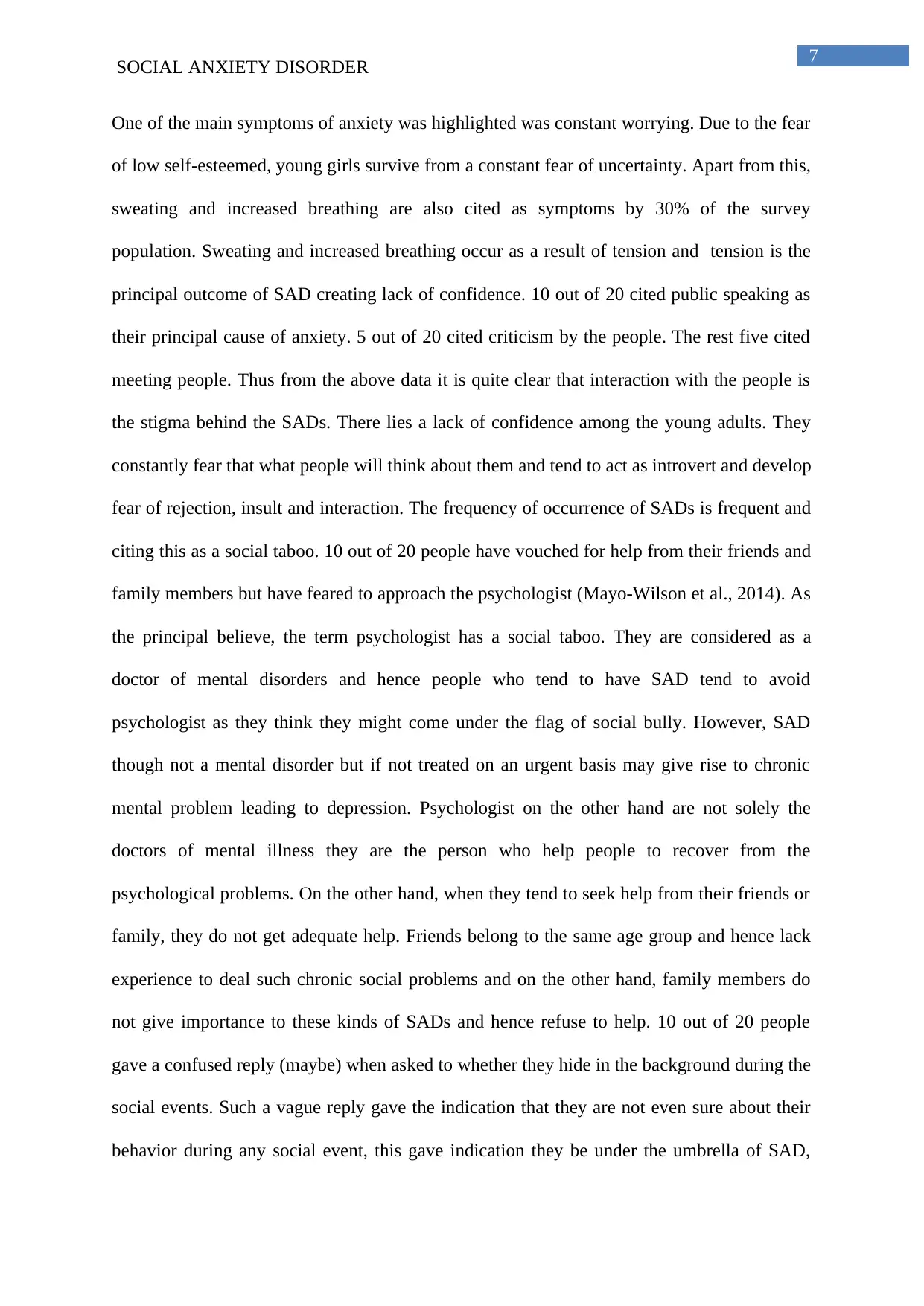
7
SOCIAL ANXIETY DISORDER
One of the main symptoms of anxiety was highlighted was constant worrying. Due to the fear
of low self-esteemed, young girls survive from a constant fear of uncertainty. Apart from this,
sweating and increased breathing are also cited as symptoms by 30% of the survey
population. Sweating and increased breathing occur as a result of tension and tension is the
principal outcome of SAD creating lack of confidence. 10 out of 20 cited public speaking as
their principal cause of anxiety. 5 out of 20 cited criticism by the people. The rest five cited
meeting people. Thus from the above data it is quite clear that interaction with the people is
the stigma behind the SADs. There lies a lack of confidence among the young adults. They
constantly fear that what people will think about them and tend to act as introvert and develop
fear of rejection, insult and interaction. The frequency of occurrence of SADs is frequent and
citing this as a social taboo. 10 out of 20 people have vouched for help from their friends and
family members but have feared to approach the psychologist (Mayo-Wilson et al., 2014). As
the principal believe, the term psychologist has a social taboo. They are considered as a
doctor of mental disorders and hence people who tend to have SAD tend to avoid
psychologist as they think they might come under the flag of social bully. However, SAD
though not a mental disorder but if not treated on an urgent basis may give rise to chronic
mental problem leading to depression. Psychologist on the other hand are not solely the
doctors of mental illness they are the person who help people to recover from the
psychological problems. On the other hand, when they tend to seek help from their friends or
family, they do not get adequate help. Friends belong to the same age group and hence lack
experience to deal such chronic social problems and on the other hand, family members do
not give importance to these kinds of SADs and hence refuse to help. 10 out of 20 people
gave a confused reply (maybe) when asked to whether they hide in the background during the
social events. Such a vague reply gave the indication that they are not even sure about their
behavior during any social event, this gave indication they be under the umbrella of SAD,
SOCIAL ANXIETY DISORDER
One of the main symptoms of anxiety was highlighted was constant worrying. Due to the fear
of low self-esteemed, young girls survive from a constant fear of uncertainty. Apart from this,
sweating and increased breathing are also cited as symptoms by 30% of the survey
population. Sweating and increased breathing occur as a result of tension and tension is the
principal outcome of SAD creating lack of confidence. 10 out of 20 cited public speaking as
their principal cause of anxiety. 5 out of 20 cited criticism by the people. The rest five cited
meeting people. Thus from the above data it is quite clear that interaction with the people is
the stigma behind the SADs. There lies a lack of confidence among the young adults. They
constantly fear that what people will think about them and tend to act as introvert and develop
fear of rejection, insult and interaction. The frequency of occurrence of SADs is frequent and
citing this as a social taboo. 10 out of 20 people have vouched for help from their friends and
family members but have feared to approach the psychologist (Mayo-Wilson et al., 2014). As
the principal believe, the term psychologist has a social taboo. They are considered as a
doctor of mental disorders and hence people who tend to have SAD tend to avoid
psychologist as they think they might come under the flag of social bully. However, SAD
though not a mental disorder but if not treated on an urgent basis may give rise to chronic
mental problem leading to depression. Psychologist on the other hand are not solely the
doctors of mental illness they are the person who help people to recover from the
psychological problems. On the other hand, when they tend to seek help from their friends or
family, they do not get adequate help. Friends belong to the same age group and hence lack
experience to deal such chronic social problems and on the other hand, family members do
not give importance to these kinds of SADs and hence refuse to help. 10 out of 20 people
gave a confused reply (maybe) when asked to whether they hide in the background during the
social events. Such a vague reply gave the indication that they are not even sure about their
behavior during any social event, this gave indication they be under the umbrella of SAD,
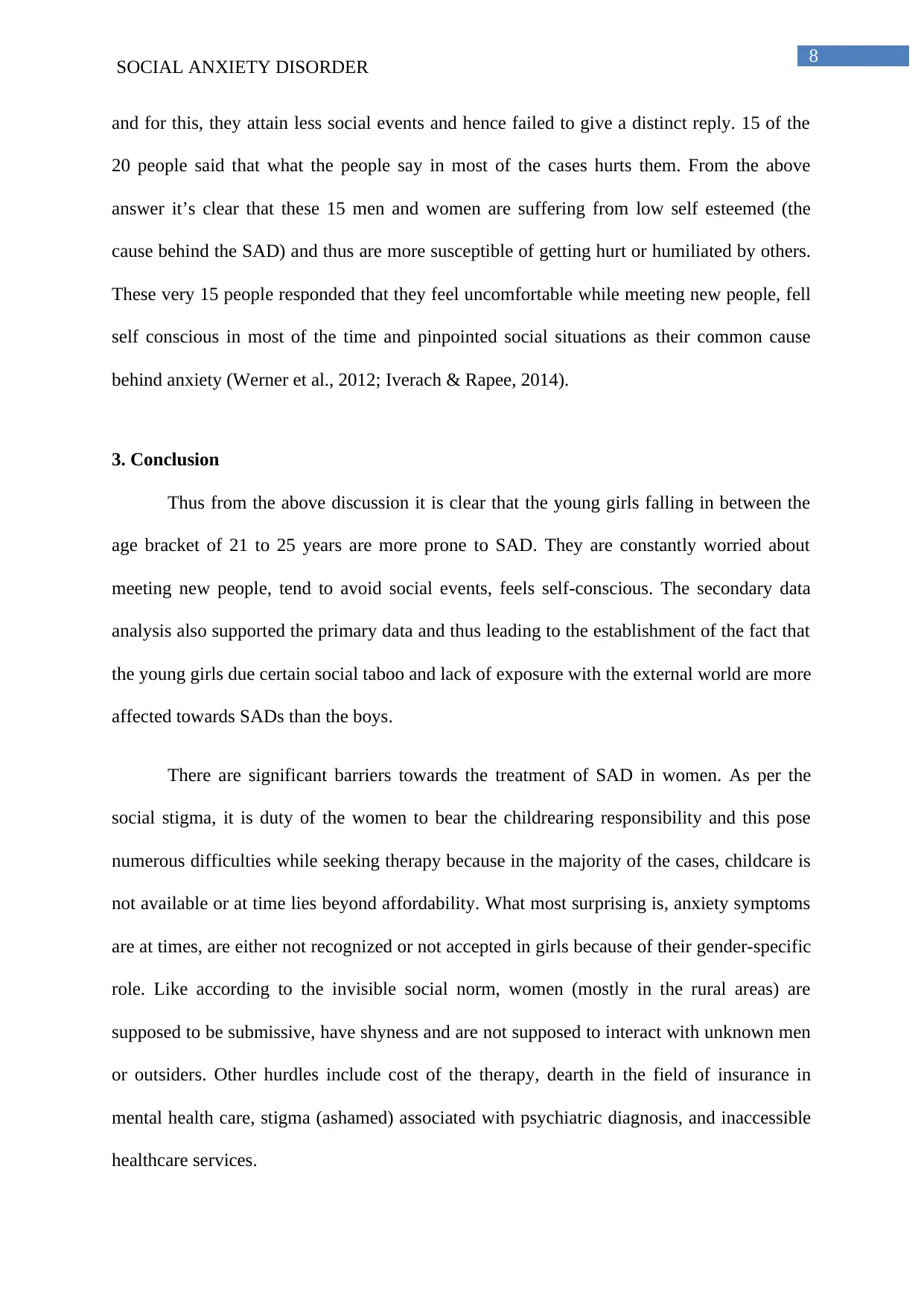
8
SOCIAL ANXIETY DISORDER
and for this, they attain less social events and hence failed to give a distinct reply. 15 of the
20 people said that what the people say in most of the cases hurts them. From the above
answer it’s clear that these 15 men and women are suffering from low self esteemed (the
cause behind the SAD) and thus are more susceptible of getting hurt or humiliated by others.
These very 15 people responded that they feel uncomfortable while meeting new people, fell
self conscious in most of the time and pinpointed social situations as their common cause
behind anxiety (Werner et al., 2012; Iverach & Rapee, 2014).
3. Conclusion
Thus from the above discussion it is clear that the young girls falling in between the
age bracket of 21 to 25 years are more prone to SAD. They are constantly worried about
meeting new people, tend to avoid social events, feels self-conscious. The secondary data
analysis also supported the primary data and thus leading to the establishment of the fact that
the young girls due certain social taboo and lack of exposure with the external world are more
affected towards SADs than the boys.
There are significant barriers towards the treatment of SAD in women. As per the
social stigma, it is duty of the women to bear the childrearing responsibility and this pose
numerous difficulties while seeking therapy because in the majority of the cases, childcare is
not available or at time lies beyond affordability. What most surprising is, anxiety symptoms
are at times, are either not recognized or not accepted in girls because of their gender-specific
role. Like according to the invisible social norm, women (mostly in the rural areas) are
supposed to be submissive, have shyness and are not supposed to interact with unknown men
or outsiders. Other hurdles include cost of the therapy, dearth in the field of insurance in
mental health care, stigma (ashamed) associated with psychiatric diagnosis, and inaccessible
healthcare services.
SOCIAL ANXIETY DISORDER
and for this, they attain less social events and hence failed to give a distinct reply. 15 of the
20 people said that what the people say in most of the cases hurts them. From the above
answer it’s clear that these 15 men and women are suffering from low self esteemed (the
cause behind the SAD) and thus are more susceptible of getting hurt or humiliated by others.
These very 15 people responded that they feel uncomfortable while meeting new people, fell
self conscious in most of the time and pinpointed social situations as their common cause
behind anxiety (Werner et al., 2012; Iverach & Rapee, 2014).
3. Conclusion
Thus from the above discussion it is clear that the young girls falling in between the
age bracket of 21 to 25 years are more prone to SAD. They are constantly worried about
meeting new people, tend to avoid social events, feels self-conscious. The secondary data
analysis also supported the primary data and thus leading to the establishment of the fact that
the young girls due certain social taboo and lack of exposure with the external world are more
affected towards SADs than the boys.
There are significant barriers towards the treatment of SAD in women. As per the
social stigma, it is duty of the women to bear the childrearing responsibility and this pose
numerous difficulties while seeking therapy because in the majority of the cases, childcare is
not available or at time lies beyond affordability. What most surprising is, anxiety symptoms
are at times, are either not recognized or not accepted in girls because of their gender-specific
role. Like according to the invisible social norm, women (mostly in the rural areas) are
supposed to be submissive, have shyness and are not supposed to interact with unknown men
or outsiders. Other hurdles include cost of the therapy, dearth in the field of insurance in
mental health care, stigma (ashamed) associated with psychiatric diagnosis, and inaccessible
healthcare services.
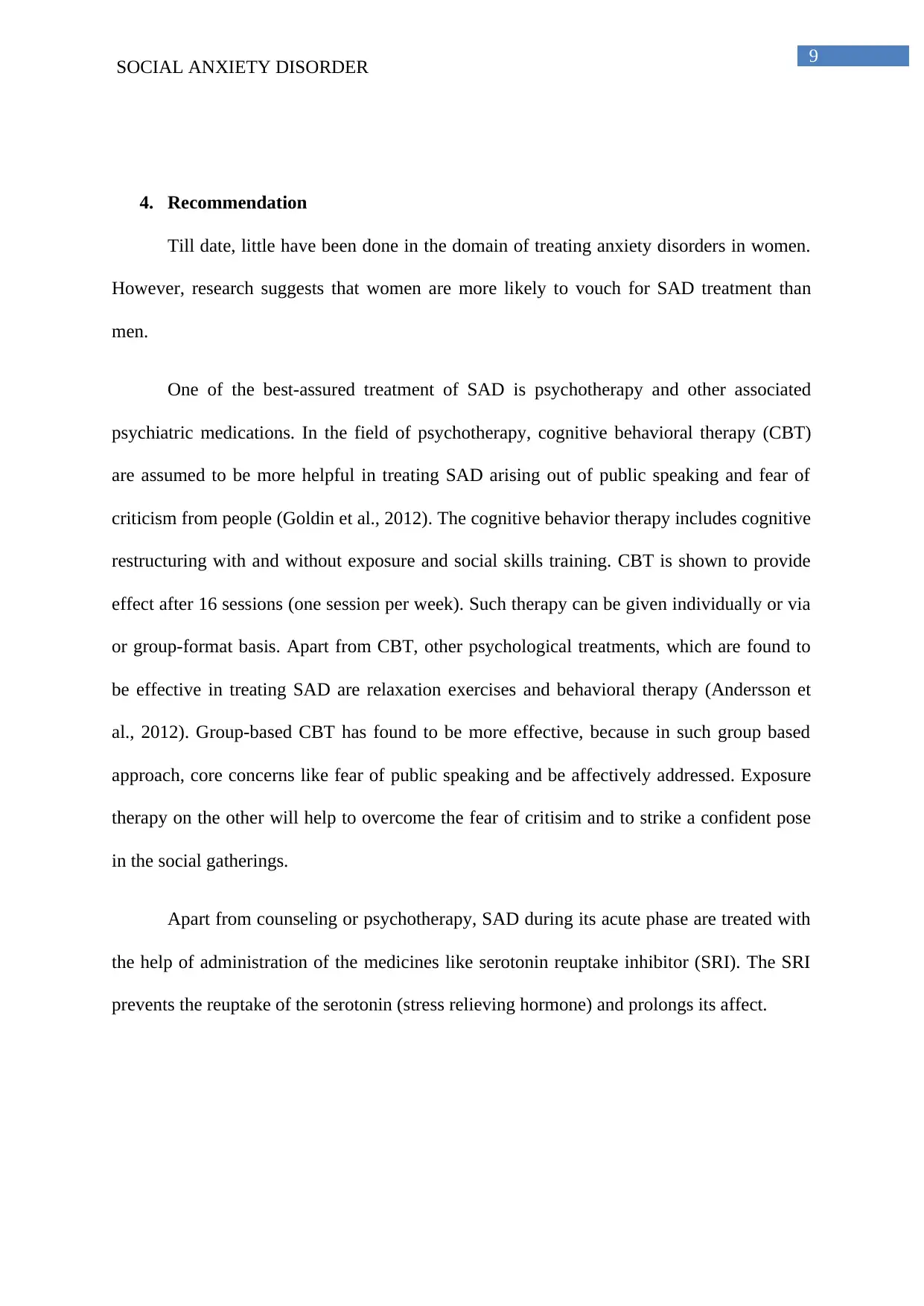
9
SOCIAL ANXIETY DISORDER
4. Recommendation
Till date, little have been done in the domain of treating anxiety disorders in women.
However, research suggests that women are more likely to vouch for SAD treatment than
men.
One of the best-assured treatment of SAD is psychotherapy and other associated
psychiatric medications. In the field of psychotherapy, cognitive behavioral therapy (CBT)
are assumed to be more helpful in treating SAD arising out of public speaking and fear of
criticism from people (Goldin et al., 2012). The cognitive behavior therapy includes cognitive
restructuring with and without exposure and social skills training. CBT is shown to provide
effect after 16 sessions (one session per week). Such therapy can be given individually or via
or group-format basis. Apart from CBT, other psychological treatments, which are found to
be effective in treating SAD are relaxation exercises and behavioral therapy (Andersson et
al., 2012). Group-based CBT has found to be more effective, because in such group based
approach, core concerns like fear of public speaking and be affectively addressed. Exposure
therapy on the other will help to overcome the fear of critisim and to strike a confident pose
in the social gatherings.
Apart from counseling or psychotherapy, SAD during its acute phase are treated with
the help of administration of the medicines like serotonin reuptake inhibitor (SRI). The SRI
prevents the reuptake of the serotonin (stress relieving hormone) and prolongs its affect.
SOCIAL ANXIETY DISORDER
4. Recommendation
Till date, little have been done in the domain of treating anxiety disorders in women.
However, research suggests that women are more likely to vouch for SAD treatment than
men.
One of the best-assured treatment of SAD is psychotherapy and other associated
psychiatric medications. In the field of psychotherapy, cognitive behavioral therapy (CBT)
are assumed to be more helpful in treating SAD arising out of public speaking and fear of
criticism from people (Goldin et al., 2012). The cognitive behavior therapy includes cognitive
restructuring with and without exposure and social skills training. CBT is shown to provide
effect after 16 sessions (one session per week). Such therapy can be given individually or via
or group-format basis. Apart from CBT, other psychological treatments, which are found to
be effective in treating SAD are relaxation exercises and behavioral therapy (Andersson et
al., 2012). Group-based CBT has found to be more effective, because in such group based
approach, core concerns like fear of public speaking and be affectively addressed. Exposure
therapy on the other will help to overcome the fear of critisim and to strike a confident pose
in the social gatherings.
Apart from counseling or psychotherapy, SAD during its acute phase are treated with
the help of administration of the medicines like serotonin reuptake inhibitor (SRI). The SRI
prevents the reuptake of the serotonin (stress relieving hormone) and prolongs its affect.
Secure Best Marks with AI Grader
Need help grading? Try our AI Grader for instant feedback on your assignments.
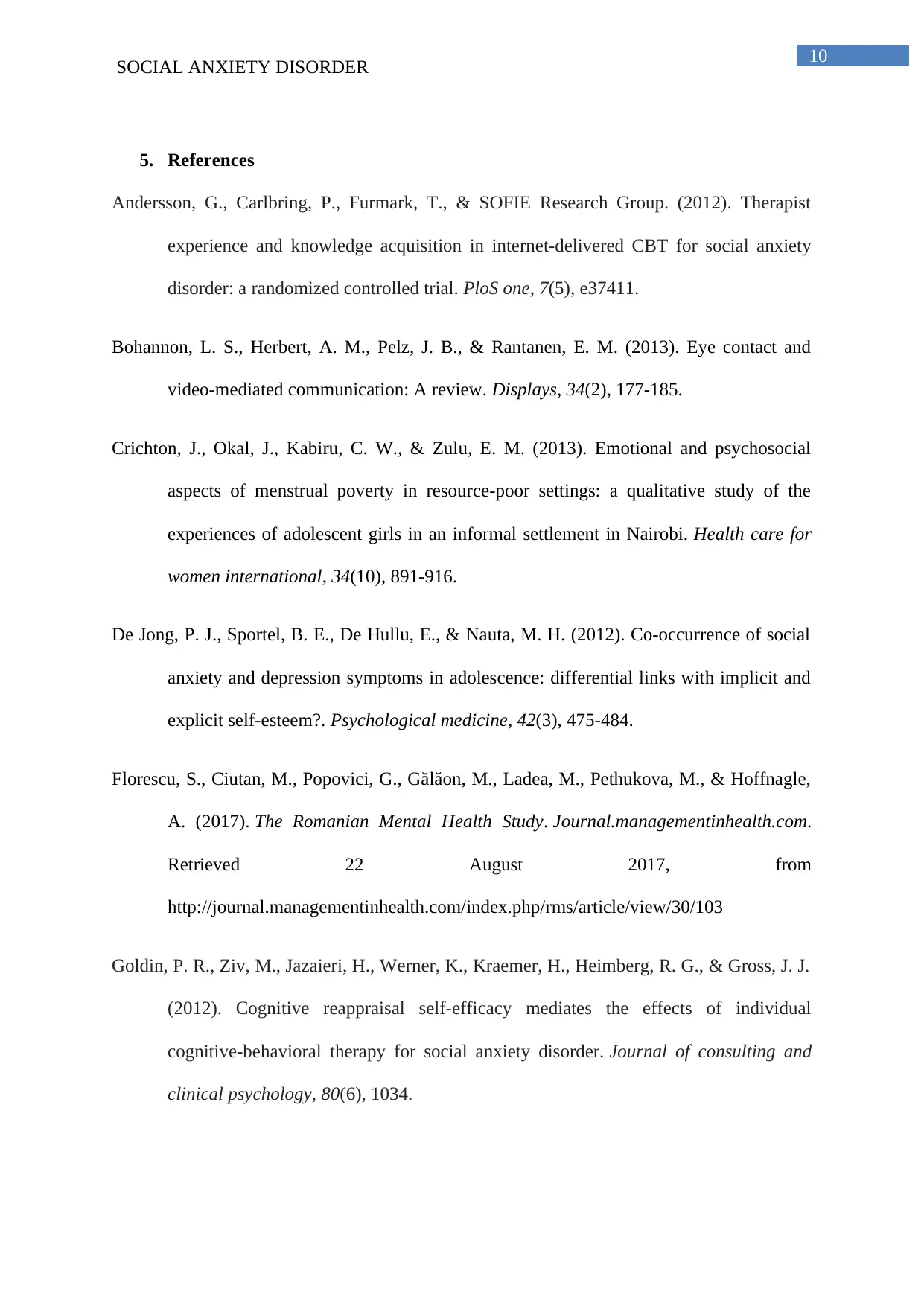
10
SOCIAL ANXIETY DISORDER
5. References
Andersson, G., Carlbring, P., Furmark, T., & SOFIE Research Group. (2012). Therapist
experience and knowledge acquisition in internet-delivered CBT for social anxiety
disorder: a randomized controlled trial. PloS one, 7(5), e37411.
Bohannon, L. S., Herbert, A. M., Pelz, J. B., & Rantanen, E. M. (2013). Eye contact and
video-mediated communication: A review. Displays, 34(2), 177-185.
Crichton, J., Okal, J., Kabiru, C. W., & Zulu, E. M. (2013). Emotional and psychosocial
aspects of menstrual poverty in resource-poor settings: a qualitative study of the
experiences of adolescent girls in an informal settlement in Nairobi. Health care for
women international, 34(10), 891-916.
De Jong, P. J., Sportel, B. E., De Hullu, E., & Nauta, M. H. (2012). Co-occurrence of social
anxiety and depression symptoms in adolescence: differential links with implicit and
explicit self-esteem?. Psychological medicine, 42(3), 475-484.
Florescu, S., Ciutan, M., Popovici, G., Gălăon, M., Ladea, M., Pethukova, M., & Hoffnagle,
A. (2017). The Romanian Mental Health Study. Journal.managementinhealth.com.
Retrieved 22 August 2017, from
http://journal.managementinhealth.com/index.php/rms/article/view/30/103
Goldin, P. R., Ziv, M., Jazaieri, H., Werner, K., Kraemer, H., Heimberg, R. G., & Gross, J. J.
(2012). Cognitive reappraisal self-efficacy mediates the effects of individual
cognitive-behavioral therapy for social anxiety disorder. Journal of consulting and
clinical psychology, 80(6), 1034.
SOCIAL ANXIETY DISORDER
5. References
Andersson, G., Carlbring, P., Furmark, T., & SOFIE Research Group. (2012). Therapist
experience and knowledge acquisition in internet-delivered CBT for social anxiety
disorder: a randomized controlled trial. PloS one, 7(5), e37411.
Bohannon, L. S., Herbert, A. M., Pelz, J. B., & Rantanen, E. M. (2013). Eye contact and
video-mediated communication: A review. Displays, 34(2), 177-185.
Crichton, J., Okal, J., Kabiru, C. W., & Zulu, E. M. (2013). Emotional and psychosocial
aspects of menstrual poverty in resource-poor settings: a qualitative study of the
experiences of adolescent girls in an informal settlement in Nairobi. Health care for
women international, 34(10), 891-916.
De Jong, P. J., Sportel, B. E., De Hullu, E., & Nauta, M. H. (2012). Co-occurrence of social
anxiety and depression symptoms in adolescence: differential links with implicit and
explicit self-esteem?. Psychological medicine, 42(3), 475-484.
Florescu, S., Ciutan, M., Popovici, G., Gălăon, M., Ladea, M., Pethukova, M., & Hoffnagle,
A. (2017). The Romanian Mental Health Study. Journal.managementinhealth.com.
Retrieved 22 August 2017, from
http://journal.managementinhealth.com/index.php/rms/article/view/30/103
Goldin, P. R., Ziv, M., Jazaieri, H., Werner, K., Kraemer, H., Heimberg, R. G., & Gross, J. J.
(2012). Cognitive reappraisal self-efficacy mediates the effects of individual
cognitive-behavioral therapy for social anxiety disorder. Journal of consulting and
clinical psychology, 80(6), 1034.
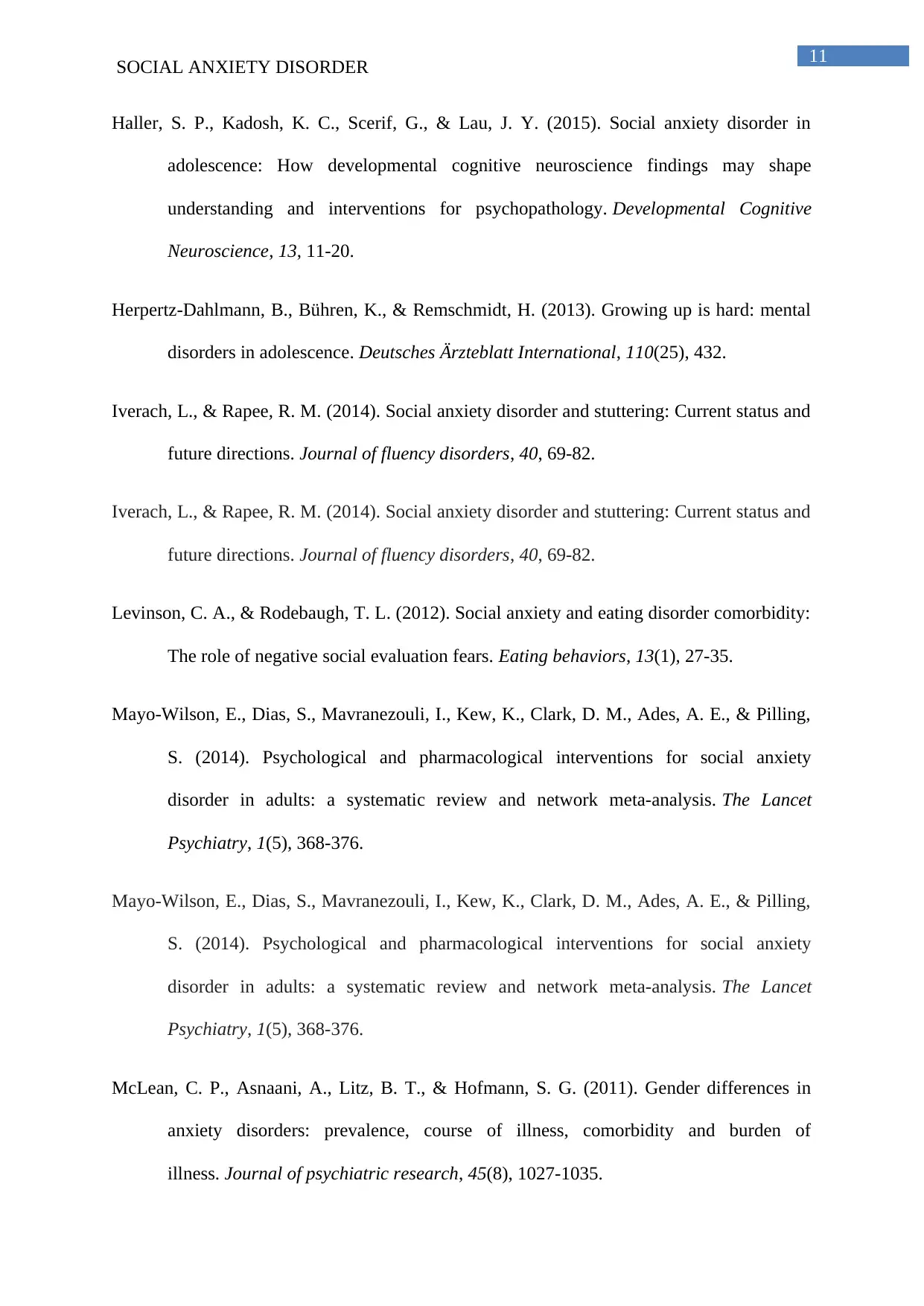
11
SOCIAL ANXIETY DISORDER
Haller, S. P., Kadosh, K. C., Scerif, G., & Lau, J. Y. (2015). Social anxiety disorder in
adolescence: How developmental cognitive neuroscience findings may shape
understanding and interventions for psychopathology. Developmental Cognitive
Neuroscience, 13, 11-20.
Herpertz-Dahlmann, B., Bühren, K., & Remschmidt, H. (2013). Growing up is hard: mental
disorders in adolescence. Deutsches Ärzteblatt International, 110(25), 432.
Iverach, L., & Rapee, R. M. (2014). Social anxiety disorder and stuttering: Current status and
future directions. Journal of fluency disorders, 40, 69-82.
Iverach, L., & Rapee, R. M. (2014). Social anxiety disorder and stuttering: Current status and
future directions. Journal of fluency disorders, 40, 69-82.
Levinson, C. A., & Rodebaugh, T. L. (2012). Social anxiety and eating disorder comorbidity:
The role of negative social evaluation fears. Eating behaviors, 13(1), 27-35.
Mayo-Wilson, E., Dias, S., Mavranezouli, I., Kew, K., Clark, D. M., Ades, A. E., & Pilling,
S. (2014). Psychological and pharmacological interventions for social anxiety
disorder in adults: a systematic review and network meta-analysis. The Lancet
Psychiatry, 1(5), 368-376.
Mayo-Wilson, E., Dias, S., Mavranezouli, I., Kew, K., Clark, D. M., Ades, A. E., & Pilling,
S. (2014). Psychological and pharmacological interventions for social anxiety
disorder in adults: a systematic review and network meta-analysis. The Lancet
Psychiatry, 1(5), 368-376.
McLean, C. P., Asnaani, A., Litz, B. T., & Hofmann, S. G. (2011). Gender differences in
anxiety disorders: prevalence, course of illness, comorbidity and burden of
illness. Journal of psychiatric research, 45(8), 1027-1035.
SOCIAL ANXIETY DISORDER
Haller, S. P., Kadosh, K. C., Scerif, G., & Lau, J. Y. (2015). Social anxiety disorder in
adolescence: How developmental cognitive neuroscience findings may shape
understanding and interventions for psychopathology. Developmental Cognitive
Neuroscience, 13, 11-20.
Herpertz-Dahlmann, B., Bühren, K., & Remschmidt, H. (2013). Growing up is hard: mental
disorders in adolescence. Deutsches Ärzteblatt International, 110(25), 432.
Iverach, L., & Rapee, R. M. (2014). Social anxiety disorder and stuttering: Current status and
future directions. Journal of fluency disorders, 40, 69-82.
Iverach, L., & Rapee, R. M. (2014). Social anxiety disorder and stuttering: Current status and
future directions. Journal of fluency disorders, 40, 69-82.
Levinson, C. A., & Rodebaugh, T. L. (2012). Social anxiety and eating disorder comorbidity:
The role of negative social evaluation fears. Eating behaviors, 13(1), 27-35.
Mayo-Wilson, E., Dias, S., Mavranezouli, I., Kew, K., Clark, D. M., Ades, A. E., & Pilling,
S. (2014). Psychological and pharmacological interventions for social anxiety
disorder in adults: a systematic review and network meta-analysis. The Lancet
Psychiatry, 1(5), 368-376.
Mayo-Wilson, E., Dias, S., Mavranezouli, I., Kew, K., Clark, D. M., Ades, A. E., & Pilling,
S. (2014). Psychological and pharmacological interventions for social anxiety
disorder in adults: a systematic review and network meta-analysis. The Lancet
Psychiatry, 1(5), 368-376.
McLean, C. P., Asnaani, A., Litz, B. T., & Hofmann, S. G. (2011). Gender differences in
anxiety disorders: prevalence, course of illness, comorbidity and burden of
illness. Journal of psychiatric research, 45(8), 1027-1035.
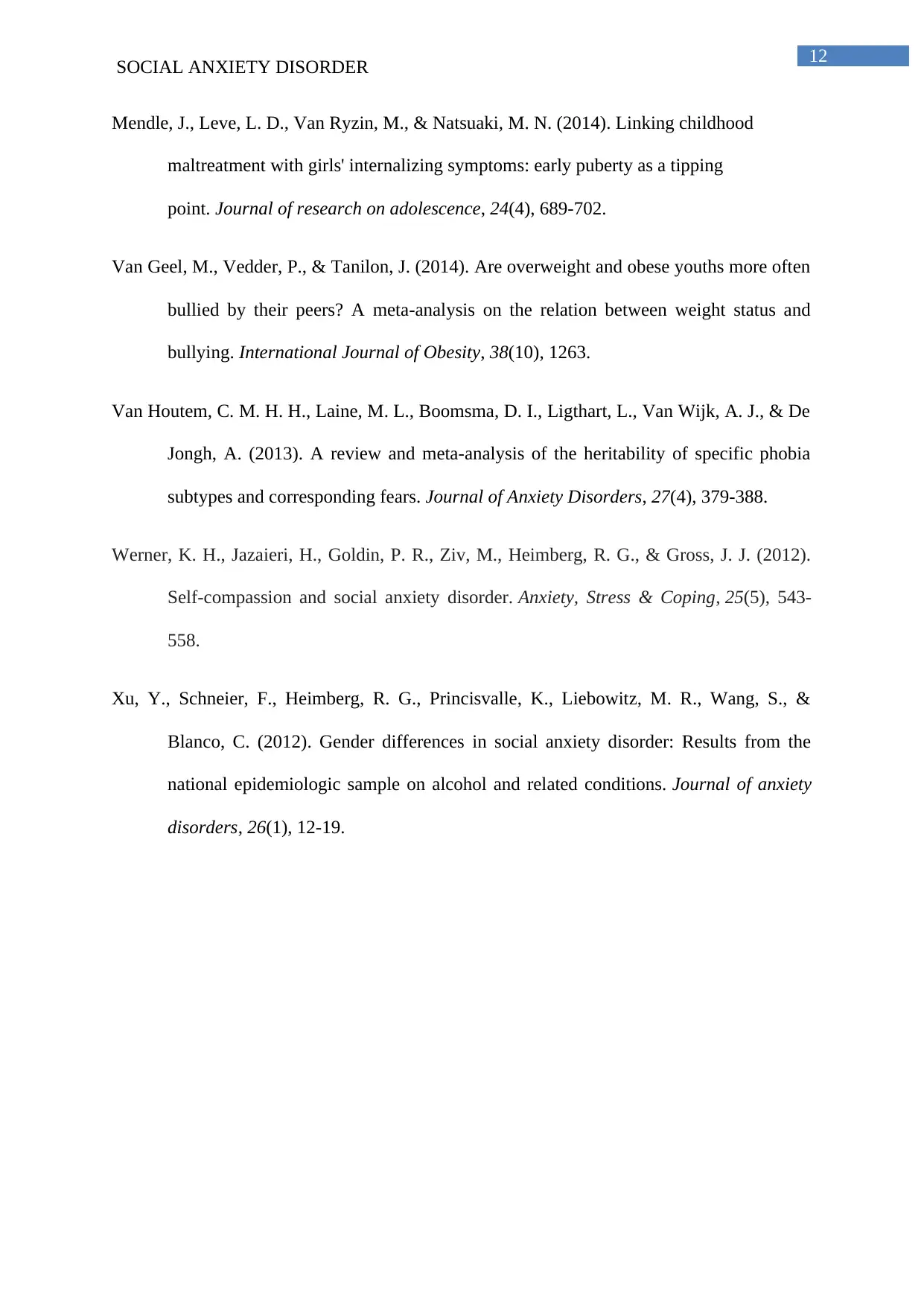
12
SOCIAL ANXIETY DISORDER
Mendle, J., Leve, L. D., Van Ryzin, M., & Natsuaki, M. N. (2014). Linking childhood
maltreatment with girls' internalizing symptoms: early puberty as a tipping
point. Journal of research on adolescence, 24(4), 689-702.
Van Geel, M., Vedder, P., & Tanilon, J. (2014). Are overweight and obese youths more often
bullied by their peers? A meta-analysis on the relation between weight status and
bullying. International Journal of Obesity, 38(10), 1263.
Van Houtem, C. M. H. H., Laine, M. L., Boomsma, D. I., Ligthart, L., Van Wijk, A. J., & De
Jongh, A. (2013). A review and meta-analysis of the heritability of specific phobia
subtypes and corresponding fears. Journal of Anxiety Disorders, 27(4), 379-388.
Werner, K. H., Jazaieri, H., Goldin, P. R., Ziv, M., Heimberg, R. G., & Gross, J. J. (2012).
Self-compassion and social anxiety disorder. Anxiety, Stress & Coping, 25(5), 543-
558.
Xu, Y., Schneier, F., Heimberg, R. G., Princisvalle, K., Liebowitz, M. R., Wang, S., &
Blanco, C. (2012). Gender differences in social anxiety disorder: Results from the
national epidemiologic sample on alcohol and related conditions. Journal of anxiety
disorders, 26(1), 12-19.
SOCIAL ANXIETY DISORDER
Mendle, J., Leve, L. D., Van Ryzin, M., & Natsuaki, M. N. (2014). Linking childhood
maltreatment with girls' internalizing symptoms: early puberty as a tipping
point. Journal of research on adolescence, 24(4), 689-702.
Van Geel, M., Vedder, P., & Tanilon, J. (2014). Are overweight and obese youths more often
bullied by their peers? A meta-analysis on the relation between weight status and
bullying. International Journal of Obesity, 38(10), 1263.
Van Houtem, C. M. H. H., Laine, M. L., Boomsma, D. I., Ligthart, L., Van Wijk, A. J., & De
Jongh, A. (2013). A review and meta-analysis of the heritability of specific phobia
subtypes and corresponding fears. Journal of Anxiety Disorders, 27(4), 379-388.
Werner, K. H., Jazaieri, H., Goldin, P. R., Ziv, M., Heimberg, R. G., & Gross, J. J. (2012).
Self-compassion and social anxiety disorder. Anxiety, Stress & Coping, 25(5), 543-
558.
Xu, Y., Schneier, F., Heimberg, R. G., Princisvalle, K., Liebowitz, M. R., Wang, S., &
Blanco, C. (2012). Gender differences in social anxiety disorder: Results from the
national epidemiologic sample on alcohol and related conditions. Journal of anxiety
disorders, 26(1), 12-19.
Paraphrase This Document
Need a fresh take? Get an instant paraphrase of this document with our AI Paraphraser
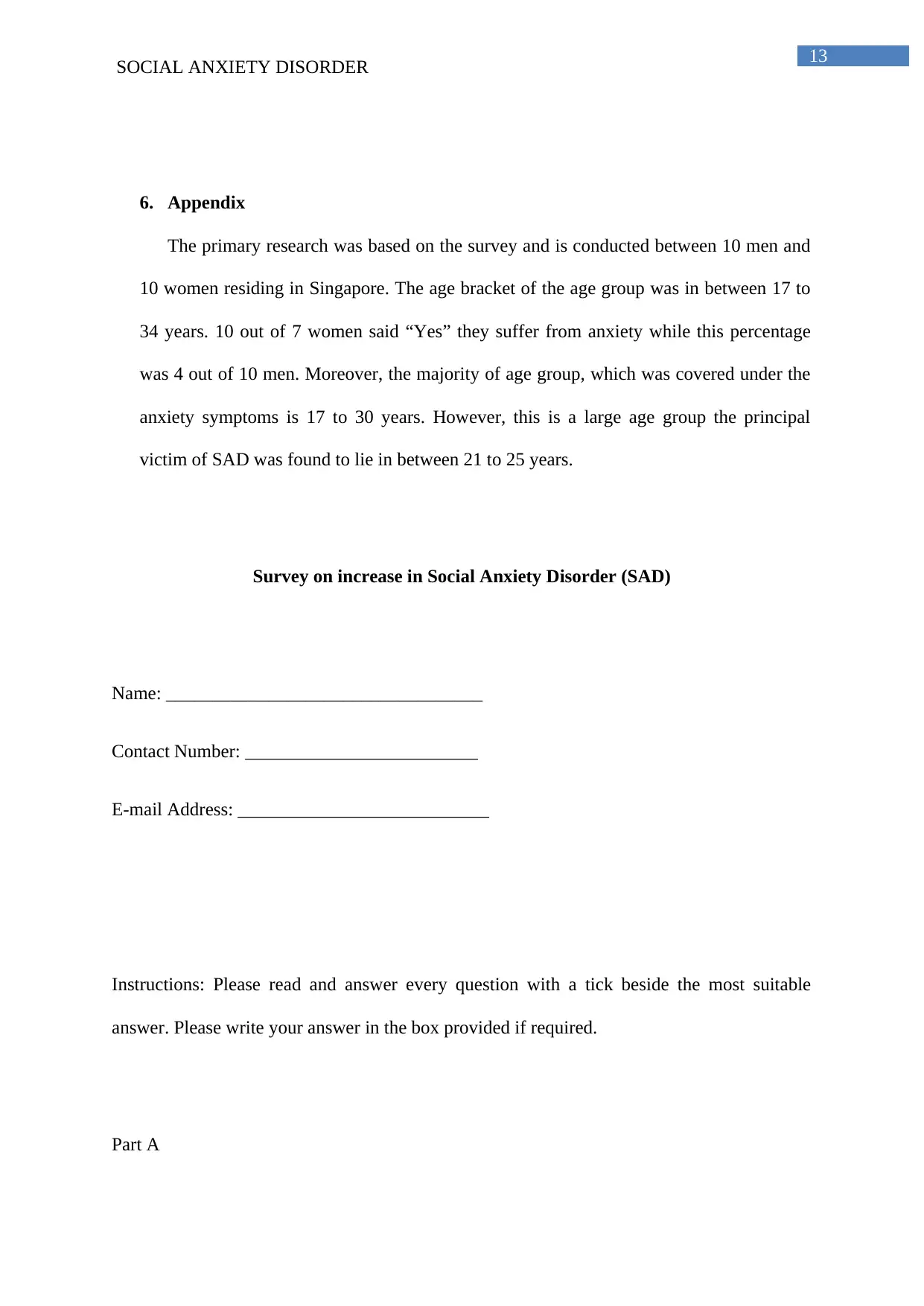
13
SOCIAL ANXIETY DISORDER
6. Appendix
The primary research was based on the survey and is conducted between 10 men and
10 women residing in Singapore. The age bracket of the age group was in between 17 to
34 years. 10 out of 7 women said “Yes” they suffer from anxiety while this percentage
was 4 out of 10 men. Moreover, the majority of age group, which was covered under the
anxiety symptoms is 17 to 30 years. However, this is a large age group the principal
victim of SAD was found to lie in between 21 to 25 years.
Survey on increase in Social Anxiety Disorder (SAD)
Name: __________________________________
Contact Number: _________________________
E-mail Address: ___________________________
Instructions: Please read and answer every question with a tick beside the most suitable
answer. Please write your answer in the box provided if required.
Part A
SOCIAL ANXIETY DISORDER
6. Appendix
The primary research was based on the survey and is conducted between 10 men and
10 women residing in Singapore. The age bracket of the age group was in between 17 to
34 years. 10 out of 7 women said “Yes” they suffer from anxiety while this percentage
was 4 out of 10 men. Moreover, the majority of age group, which was covered under the
anxiety symptoms is 17 to 30 years. However, this is a large age group the principal
victim of SAD was found to lie in between 21 to 25 years.
Survey on increase in Social Anxiety Disorder (SAD)
Name: __________________________________
Contact Number: _________________________
E-mail Address: ___________________________
Instructions: Please read and answer every question with a tick beside the most suitable
answer. Please write your answer in the box provided if required.
Part A
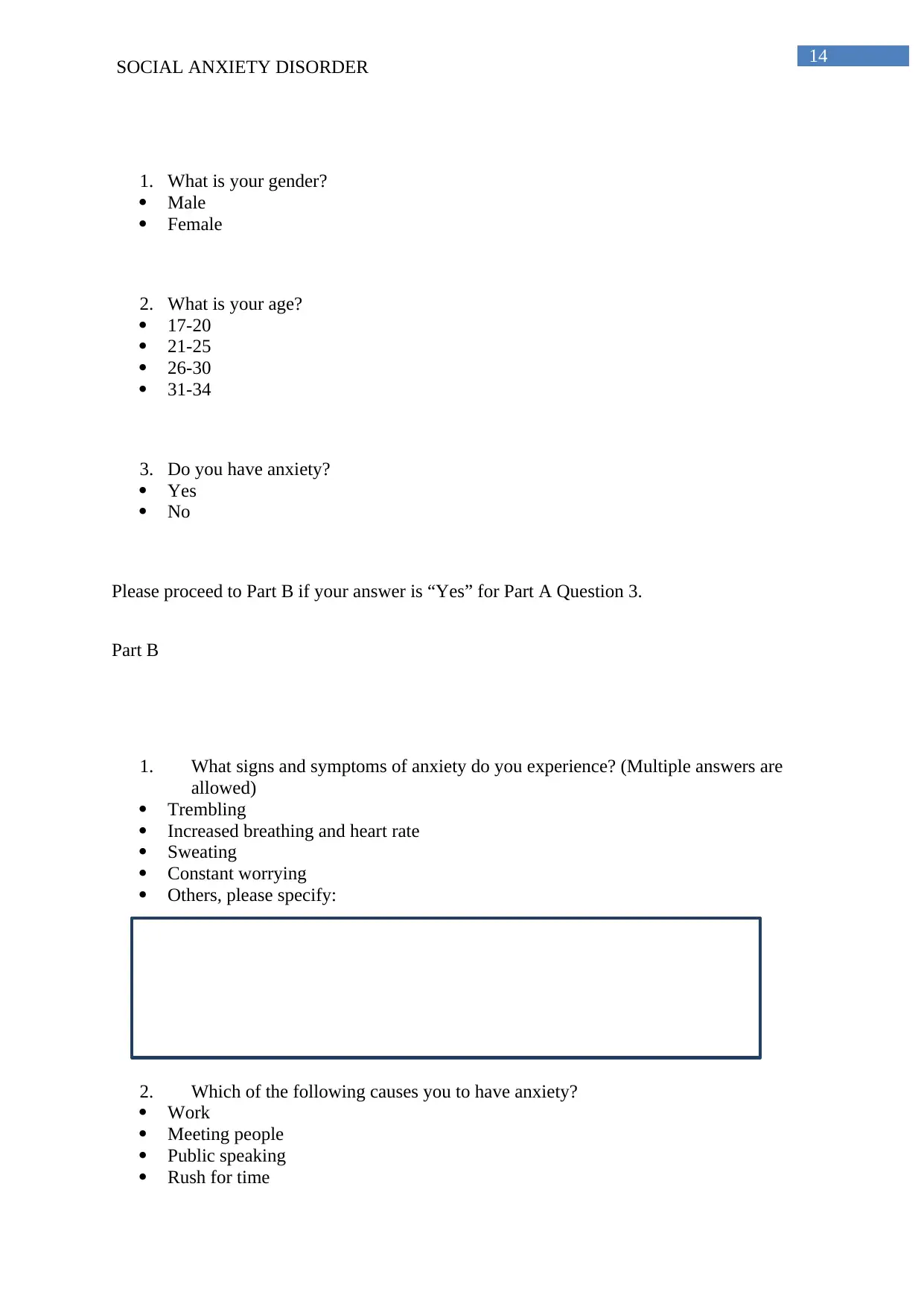
14
SOCIAL ANXIETY DISORDER
1. What is your gender?
Male
Female
2. What is your age?
17-20
21-25
26-30
31-34
3. Do you have anxiety?
Yes
No
Please proceed to Part B if your answer is “Yes” for Part A Question 3.
Part B
1. What signs and symptoms of anxiety do you experience? (Multiple answers are
allowed)
Trembling
Increased breathing and heart rate
Sweating
Constant worrying
Others, please specify:
2. Which of the following causes you to have anxiety?
Work
Meeting people
Public speaking
Rush for time
SOCIAL ANXIETY DISORDER
1. What is your gender?
Male
Female
2. What is your age?
17-20
21-25
26-30
31-34
3. Do you have anxiety?
Yes
No
Please proceed to Part B if your answer is “Yes” for Part A Question 3.
Part B
1. What signs and symptoms of anxiety do you experience? (Multiple answers are
allowed)
Trembling
Increased breathing and heart rate
Sweating
Constant worrying
Others, please specify:
2. Which of the following causes you to have anxiety?
Work
Meeting people
Public speaking
Rush for time
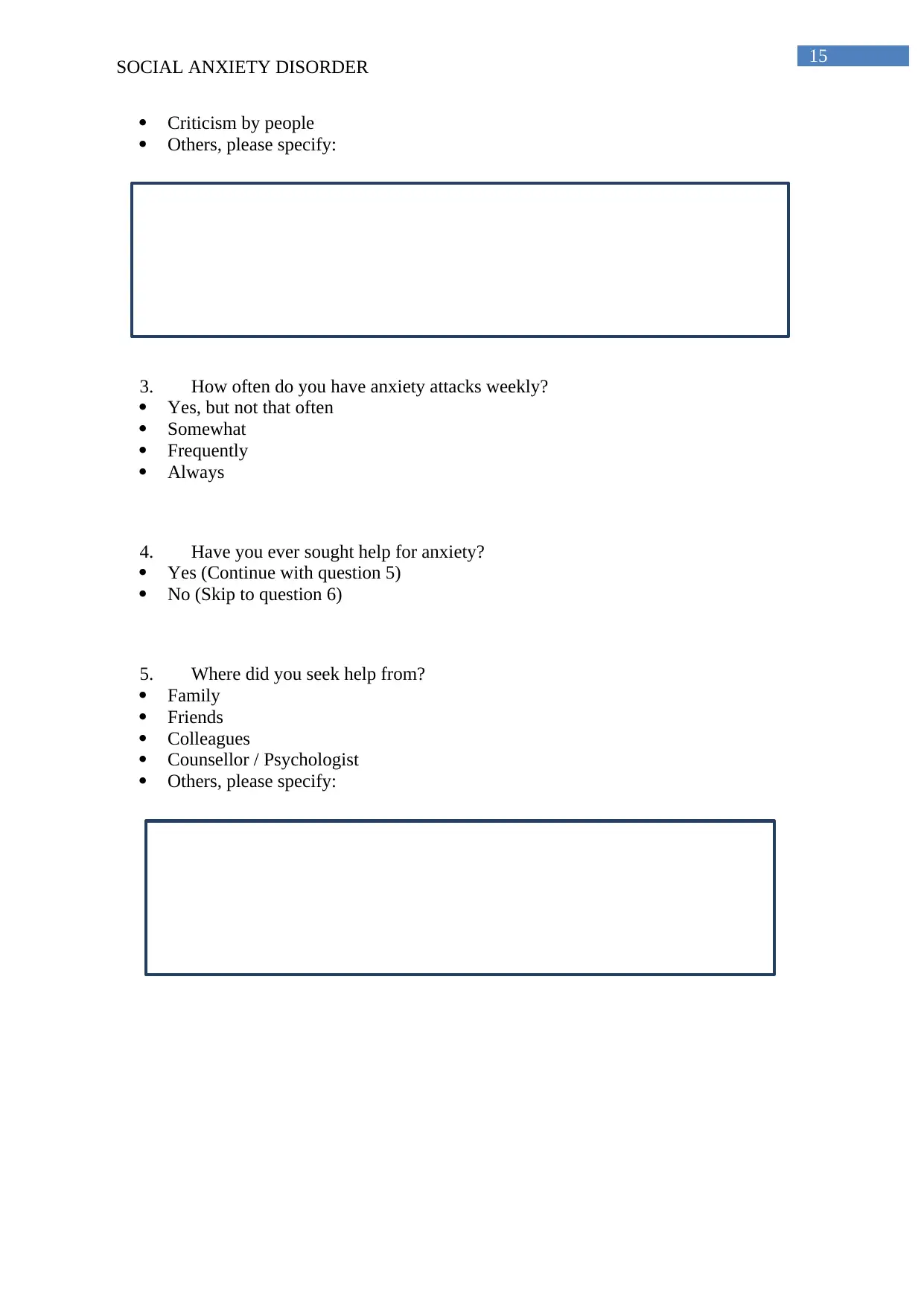
15
SOCIAL ANXIETY DISORDER
Criticism by people
Others, please specify:
3. How often do you have anxiety attacks weekly?
Yes, but not that often
Somewhat
Frequently
Always
4. Have you ever sought help for anxiety?
Yes (Continue with question 5)
No (Skip to question 6)
5. Where did you seek help from?
Family
Friends
Colleagues
Counsellor / Psychologist
Others, please specify:
SOCIAL ANXIETY DISORDER
Criticism by people
Others, please specify:
3. How often do you have anxiety attacks weekly?
Yes, but not that often
Somewhat
Frequently
Always
4. Have you ever sought help for anxiety?
Yes (Continue with question 5)
No (Skip to question 6)
5. Where did you seek help from?
Family
Friends
Colleagues
Counsellor / Psychologist
Others, please specify:
Secure Best Marks with AI Grader
Need help grading? Try our AI Grader for instant feedback on your assignments.
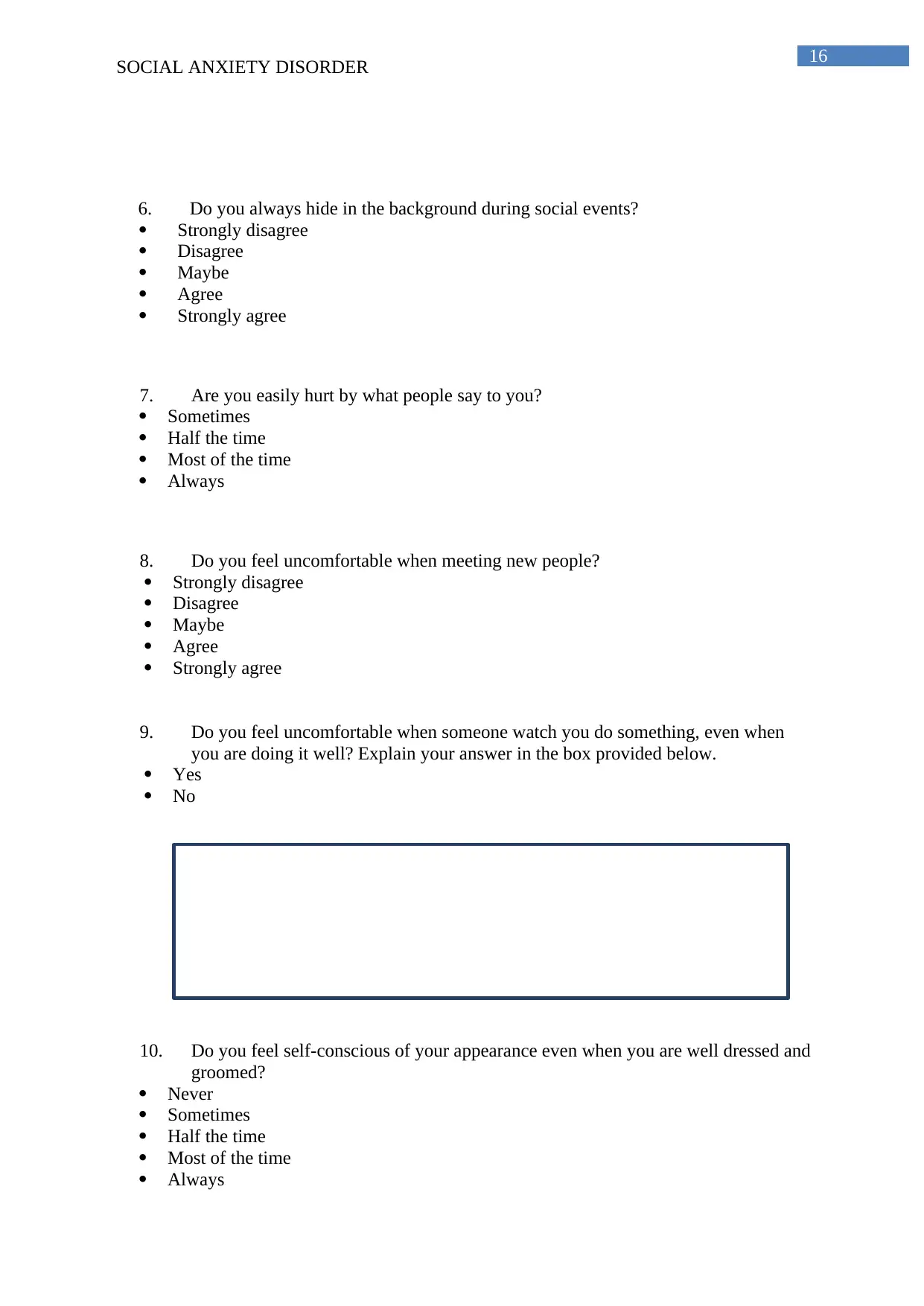
16
SOCIAL ANXIETY DISORDER
6. Do you always hide in the background during social events?
Strongly disagree
Disagree
Maybe
Agree
Strongly agree
7. Are you easily hurt by what people say to you?
Sometimes
Half the time
Most of the time
Always
8. Do you feel uncomfortable when meeting new people?
Strongly disagree
Disagree
Maybe
Agree
Strongly agree
9. Do you feel uncomfortable when someone watch you do something, even when
you are doing it well? Explain your answer in the box provided below.
Yes
No
10. Do you feel self-conscious of your appearance even when you are well dressed and
groomed?
Never
Sometimes
Half the time
Most of the time
Always
SOCIAL ANXIETY DISORDER
6. Do you always hide in the background during social events?
Strongly disagree
Disagree
Maybe
Agree
Strongly agree
7. Are you easily hurt by what people say to you?
Sometimes
Half the time
Most of the time
Always
8. Do you feel uncomfortable when meeting new people?
Strongly disagree
Disagree
Maybe
Agree
Strongly agree
9. Do you feel uncomfortable when someone watch you do something, even when
you are doing it well? Explain your answer in the box provided below.
Yes
No
10. Do you feel self-conscious of your appearance even when you are well dressed and
groomed?
Never
Sometimes
Half the time
Most of the time
Always
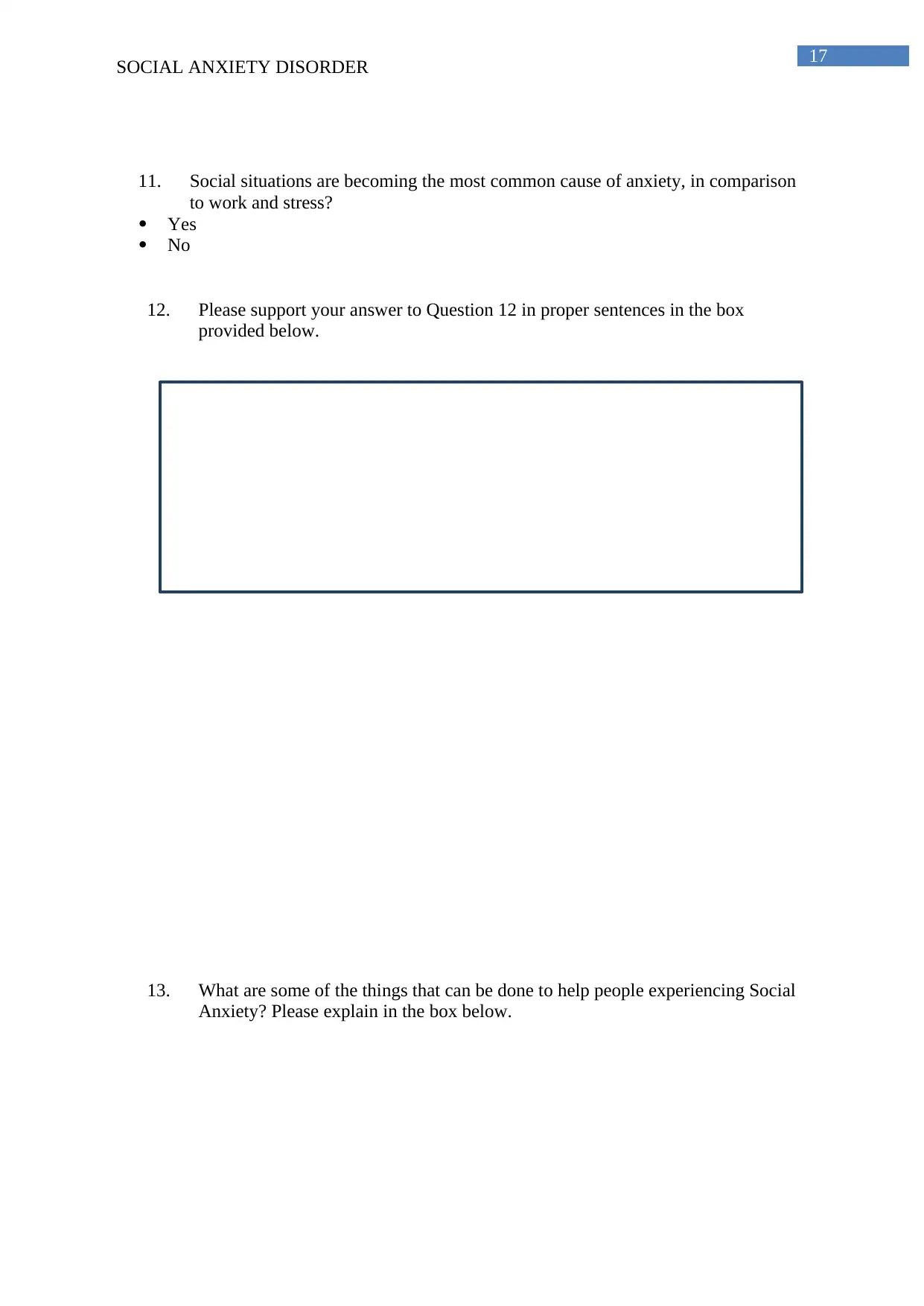
17
SOCIAL ANXIETY DISORDER
11. Social situations are becoming the most common cause of anxiety, in comparison
to work and stress?
Yes
No
12. Please support your answer to Question 12 in proper sentences in the box
provided below.
13. What are some of the things that can be done to help people experiencing Social
Anxiety? Please explain in the box below.
SOCIAL ANXIETY DISORDER
11. Social situations are becoming the most common cause of anxiety, in comparison
to work and stress?
Yes
No
12. Please support your answer to Question 12 in proper sentences in the box
provided below.
13. What are some of the things that can be done to help people experiencing Social
Anxiety? Please explain in the box below.
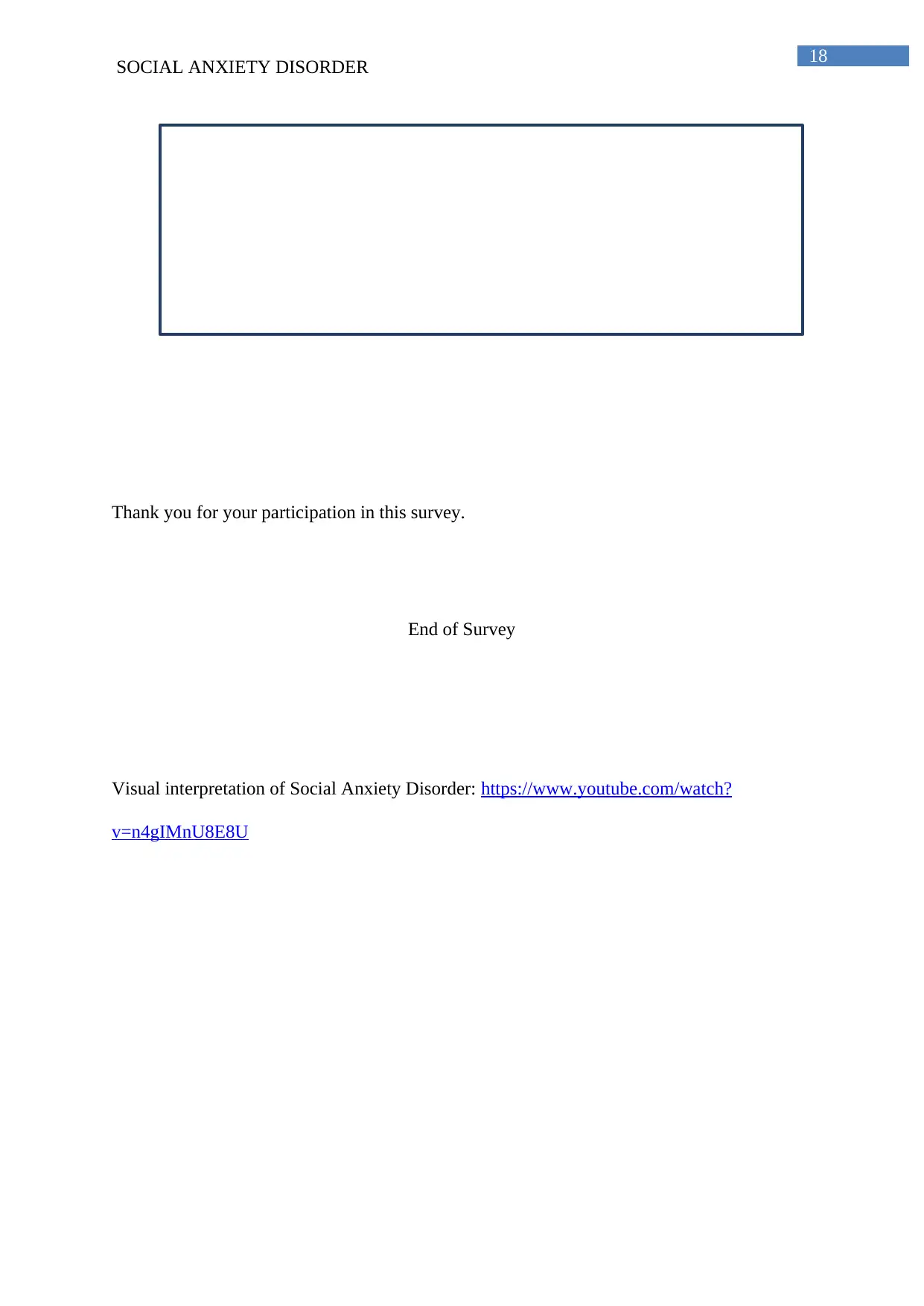
18
SOCIAL ANXIETY DISORDER
Thank you for your participation in this survey.
End of Survey
Visual interpretation of Social Anxiety Disorder: https://www.youtube.com/watch?
v=n4gIMnU8E8U
SOCIAL ANXIETY DISORDER
Thank you for your participation in this survey.
End of Survey
Visual interpretation of Social Anxiety Disorder: https://www.youtube.com/watch?
v=n4gIMnU8E8U
Paraphrase This Document
Need a fresh take? Get an instant paraphrase of this document with our AI Paraphraser
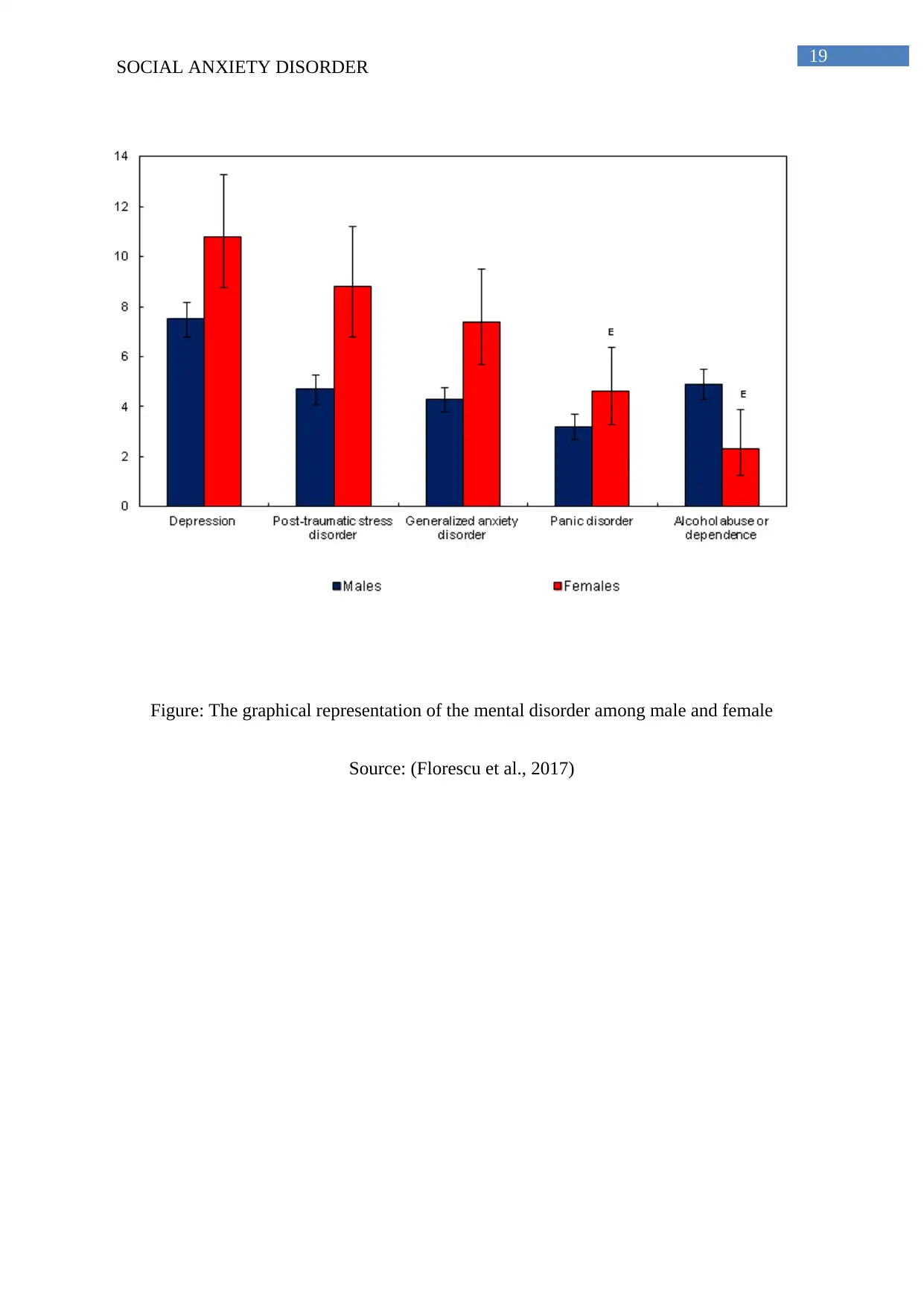
19
SOCIAL ANXIETY DISORDER
Figure: The graphical representation of the mental disorder among male and female
Source: (Florescu et al., 2017)
SOCIAL ANXIETY DISORDER
Figure: The graphical representation of the mental disorder among male and female
Source: (Florescu et al., 2017)
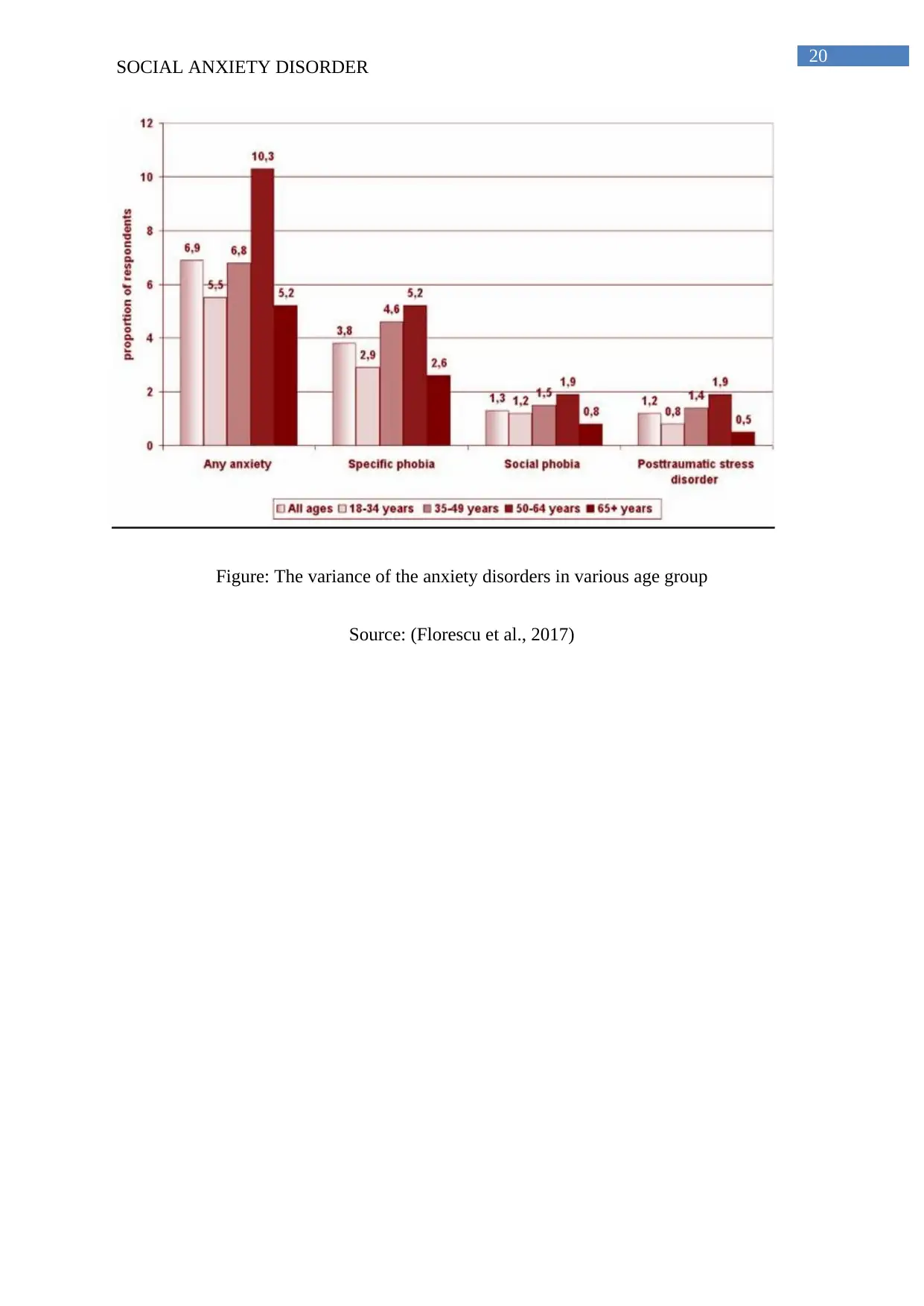
20
SOCIAL ANXIETY DISORDER
Figure: The variance of the anxiety disorders in various age group
Source: (Florescu et al., 2017)
SOCIAL ANXIETY DISORDER
Figure: The variance of the anxiety disorders in various age group
Source: (Florescu et al., 2017)
1 out of 21
Related Documents
Your All-in-One AI-Powered Toolkit for Academic Success.
+13062052269
info@desklib.com
Available 24*7 on WhatsApp / Email
![[object Object]](/_next/static/media/star-bottom.7253800d.svg)
Unlock your academic potential
© 2024 | Zucol Services PVT LTD | All rights reserved.





